Financial Management: Assessment of Financial Data and Investment Proposals
VerifiedAdded on 2023/06/07
|23
|5426
|396
AI Summary
This report focuses on the assessment of financial data and investment proposals in financial management. It covers topics such as obtaining financial data, reviewing and questioning financial data, applying analytical tools and techniques, and conducting comparative analysis. The report also discusses how to produce a budget while taking into account financial constraints, achievement of targets, legal requirements, and accounting conventions.
Contribute Materials
Your contribution can guide someone’s learning journey. Share your
documents today.
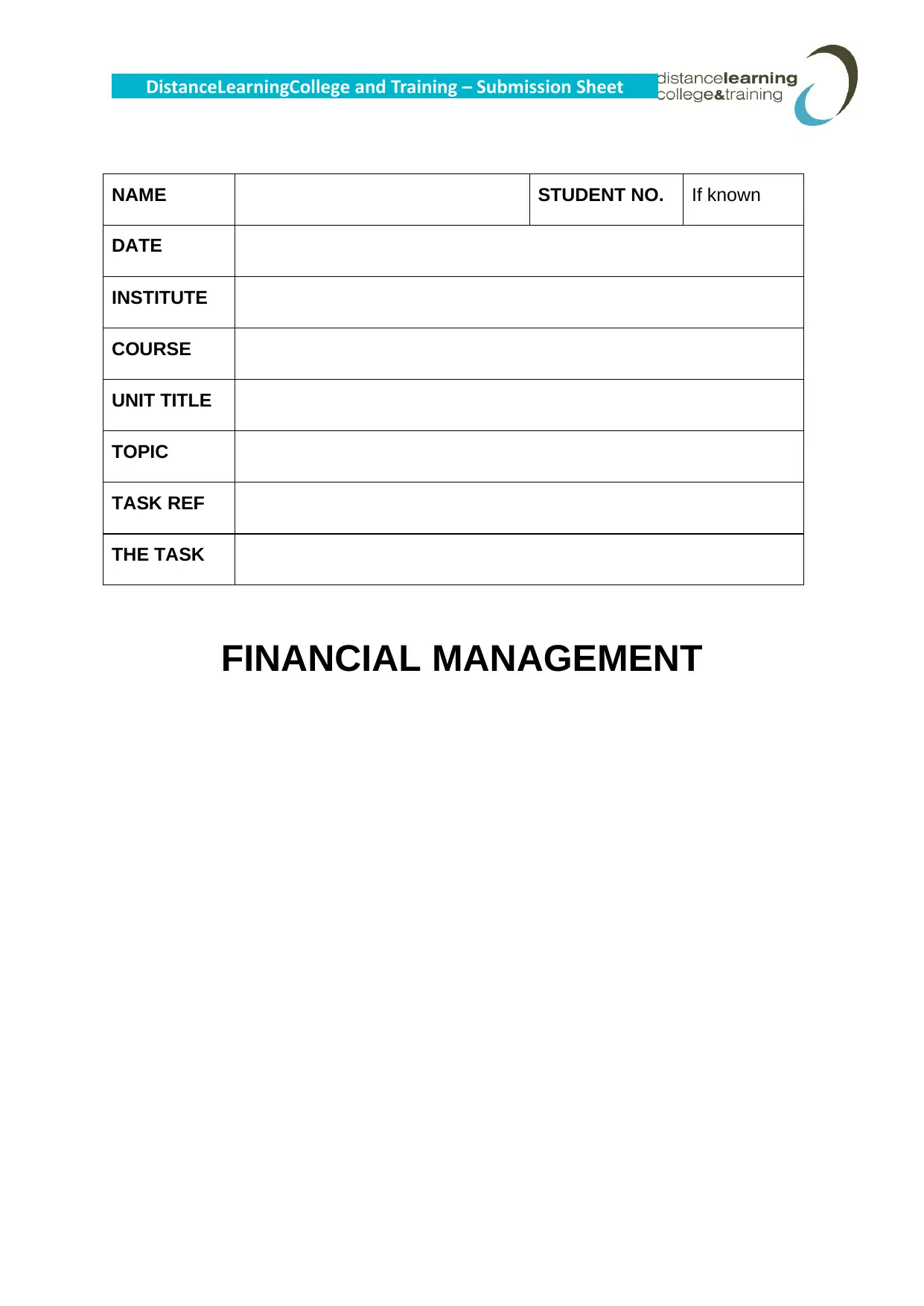
DistanceLearningCollege and Training – Submission Sheet
NAME STUDENT NO. If known
DATE
INSTITUTE
COURSE
UNIT TITLE
TOPIC
TASK REF
THE TASK
FINANCIAL MANAGEMENT
NAME STUDENT NO. If known
DATE
INSTITUTE
COURSE
UNIT TITLE
TOPIC
TASK REF
THE TASK
FINANCIAL MANAGEMENT
Secure Best Marks with AI Grader
Need help grading? Try our AI Grader for instant feedback on your assignments.
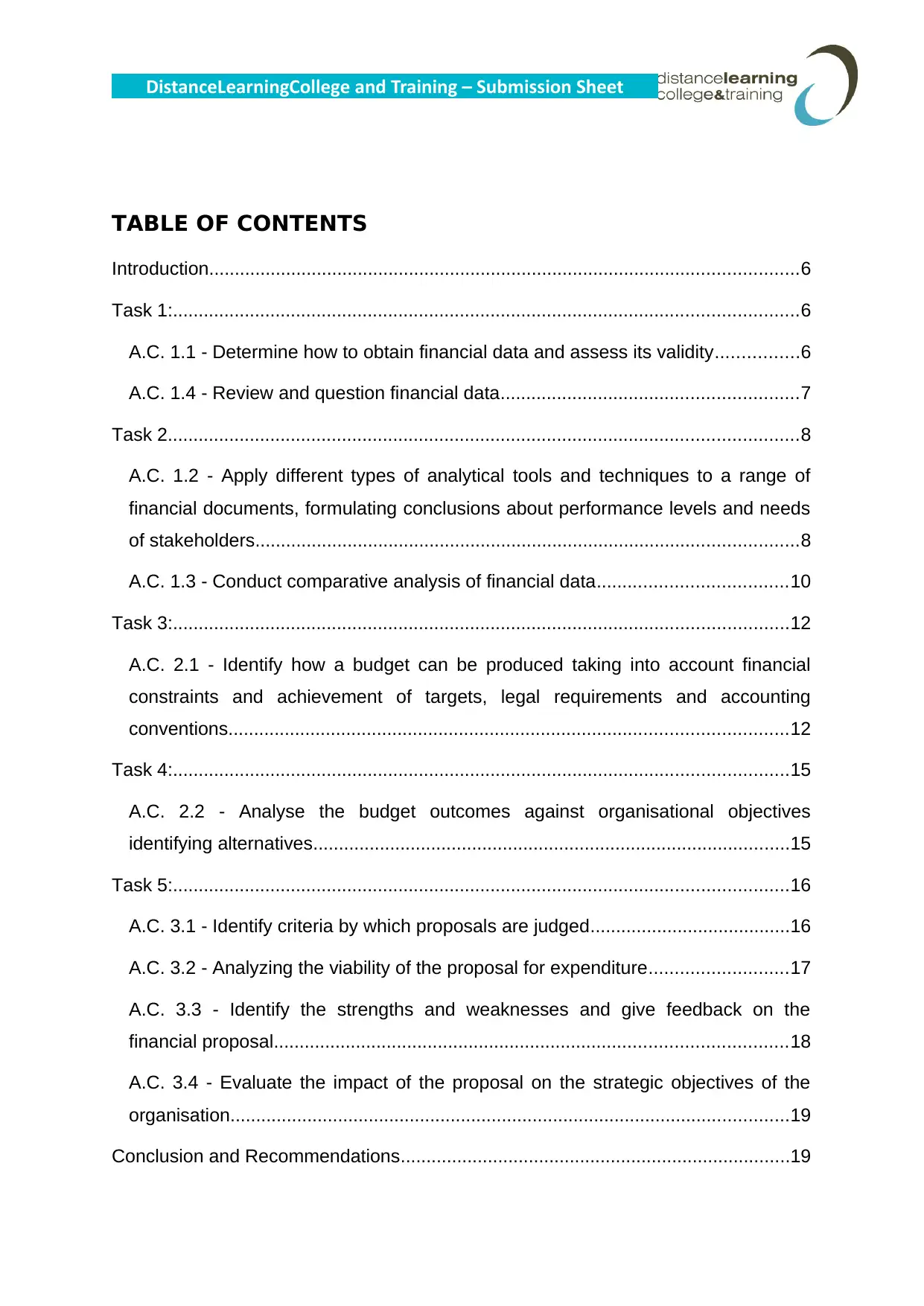
DistanceLearningCollege and Training – Submission Sheet
TABLE OF CONTENTS
Introduction...................................................................................................................6
Task 1:..........................................................................................................................6
A.C. 1.1 - Determine how to obtain financial data and assess its validity................6
A.C. 1.4 - Review and question financial data..........................................................7
Task 2...........................................................................................................................8
A.C. 1.2 - Apply different types of analytical tools and techniques to a range of
financial documents, formulating conclusions about performance levels and needs
of stakeholders..........................................................................................................8
A.C. 1.3 - Conduct comparative analysis of financial data.....................................10
Task 3:........................................................................................................................12
A.C. 2.1 - Identify how a budget can be produced taking into account financial
constraints and achievement of targets, legal requirements and accounting
conventions.............................................................................................................12
Task 4:........................................................................................................................15
A.C. 2.2 - Analyse the budget outcomes against organisational objectives
identifying alternatives.............................................................................................15
Task 5:........................................................................................................................16
A.C. 3.1 - Identify criteria by which proposals are judged.......................................16
A.C. 3.2 - Analyzing the viability of the proposal for expenditure...........................17
A.C. 3.3 - Identify the strengths and weaknesses and give feedback on the
financial proposal....................................................................................................18
A.C. 3.4 - Evaluate the impact of the proposal on the strategic objectives of the
organisation.............................................................................................................19
Conclusion and Recommendations............................................................................19
TABLE OF CONTENTS
Introduction...................................................................................................................6
Task 1:..........................................................................................................................6
A.C. 1.1 - Determine how to obtain financial data and assess its validity................6
A.C. 1.4 - Review and question financial data..........................................................7
Task 2...........................................................................................................................8
A.C. 1.2 - Apply different types of analytical tools and techniques to a range of
financial documents, formulating conclusions about performance levels and needs
of stakeholders..........................................................................................................8
A.C. 1.3 - Conduct comparative analysis of financial data.....................................10
Task 3:........................................................................................................................12
A.C. 2.1 - Identify how a budget can be produced taking into account financial
constraints and achievement of targets, legal requirements and accounting
conventions.............................................................................................................12
Task 4:........................................................................................................................15
A.C. 2.2 - Analyse the budget outcomes against organisational objectives
identifying alternatives.............................................................................................15
Task 5:........................................................................................................................16
A.C. 3.1 - Identify criteria by which proposals are judged.......................................16
A.C. 3.2 - Analyzing the viability of the proposal for expenditure...........................17
A.C. 3.3 - Identify the strengths and weaknesses and give feedback on the
financial proposal....................................................................................................18
A.C. 3.4 - Evaluate the impact of the proposal on the strategic objectives of the
organisation.............................................................................................................19
Conclusion and Recommendations............................................................................19

DistanceLearningCollege and Training – Submission Sheet
References.................................................................................................................21
List of Tables
Table 1: Calculation of Ratios of Crawford Healthcare................................................5
References.................................................................................................................21
List of Tables
Table 1: Calculation of Ratios of Crawford Healthcare................................................5

DistanceLearningCollege and Training – Submission Sheet
List of Figures
Figure 1 : Approaches of Budgeting.............................................................................8
List of Figures
Figure 1 : Approaches of Budgeting.............................................................................8
Secure Best Marks with AI Grader
Need help grading? Try our AI Grader for instant feedback on your assignments.
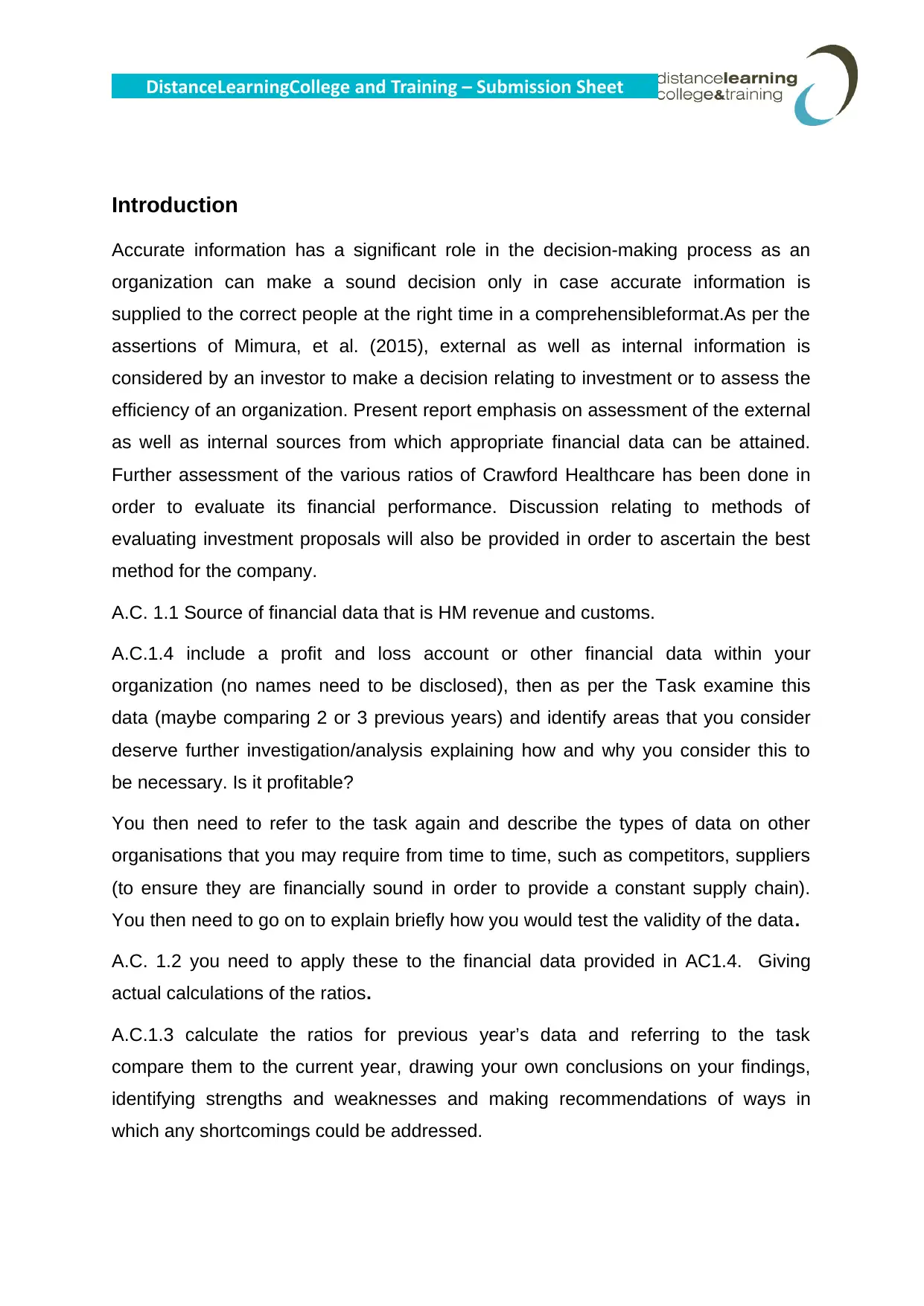
DistanceLearningCollege and Training – Submission Sheet
Introduction
Accurate information has a significant role in the decision-making process as an
organization can make a sound decision only in case accurate information is
supplied to the correct people at the right time in a comprehensibleformat.As per the
assertions of Mimura, et al. (2015), external as well as internal information is
considered by an investor to make a decision relating to investment or to assess the
efficiency of an organization. Present report emphasis on assessment of the external
as well as internal sources from which appropriate financial data can be attained.
Further assessment of the various ratios of Crawford Healthcare has been done in
order to evaluate its financial performance. Discussion relating to methods of
evaluating investment proposals will also be provided in order to ascertain the best
method for the company.
A.C. 1.1 Source of financial data that is HM revenue and customs.
A.C.1.4 include a profit and loss account or other financial data within your
organization (no names need to be disclosed), then as per the Task examine this
data (maybe comparing 2 or 3 previous years) and identify areas that you consider
deserve further investigation/analysis explaining how and why you consider this to
be necessary. Is it profitable?
You then need to refer to the task again and describe the types of data on other
organisations that you may require from time to time, such as competitors, suppliers
(to ensure they are financially sound in order to provide a constant supply chain).
You then need to go on to explain briefly how you would test the validity of the data.
A.C. 1.2 you need to apply these to the financial data provided in AC1.4. Giving
actual calculations of the ratios.
A.C.1.3 calculate the ratios for previous year’s data and referring to the task
compare them to the current year, drawing your own conclusions on your findings,
identifying strengths and weaknesses and making recommendations of ways in
which any shortcomings could be addressed.
Introduction
Accurate information has a significant role in the decision-making process as an
organization can make a sound decision only in case accurate information is
supplied to the correct people at the right time in a comprehensibleformat.As per the
assertions of Mimura, et al. (2015), external as well as internal information is
considered by an investor to make a decision relating to investment or to assess the
efficiency of an organization. Present report emphasis on assessment of the external
as well as internal sources from which appropriate financial data can be attained.
Further assessment of the various ratios of Crawford Healthcare has been done in
order to evaluate its financial performance. Discussion relating to methods of
evaluating investment proposals will also be provided in order to ascertain the best
method for the company.
A.C. 1.1 Source of financial data that is HM revenue and customs.
A.C.1.4 include a profit and loss account or other financial data within your
organization (no names need to be disclosed), then as per the Task examine this
data (maybe comparing 2 or 3 previous years) and identify areas that you consider
deserve further investigation/analysis explaining how and why you consider this to
be necessary. Is it profitable?
You then need to refer to the task again and describe the types of data on other
organisations that you may require from time to time, such as competitors, suppliers
(to ensure they are financially sound in order to provide a constant supply chain).
You then need to go on to explain briefly how you would test the validity of the data.
A.C. 1.2 you need to apply these to the financial data provided in AC1.4. Giving
actual calculations of the ratios.
A.C.1.3 calculate the ratios for previous year’s data and referring to the task
compare them to the current year, drawing your own conclusions on your findings,
identifying strengths and weaknesses and making recommendations of ways in
which any shortcomings could be addressed.
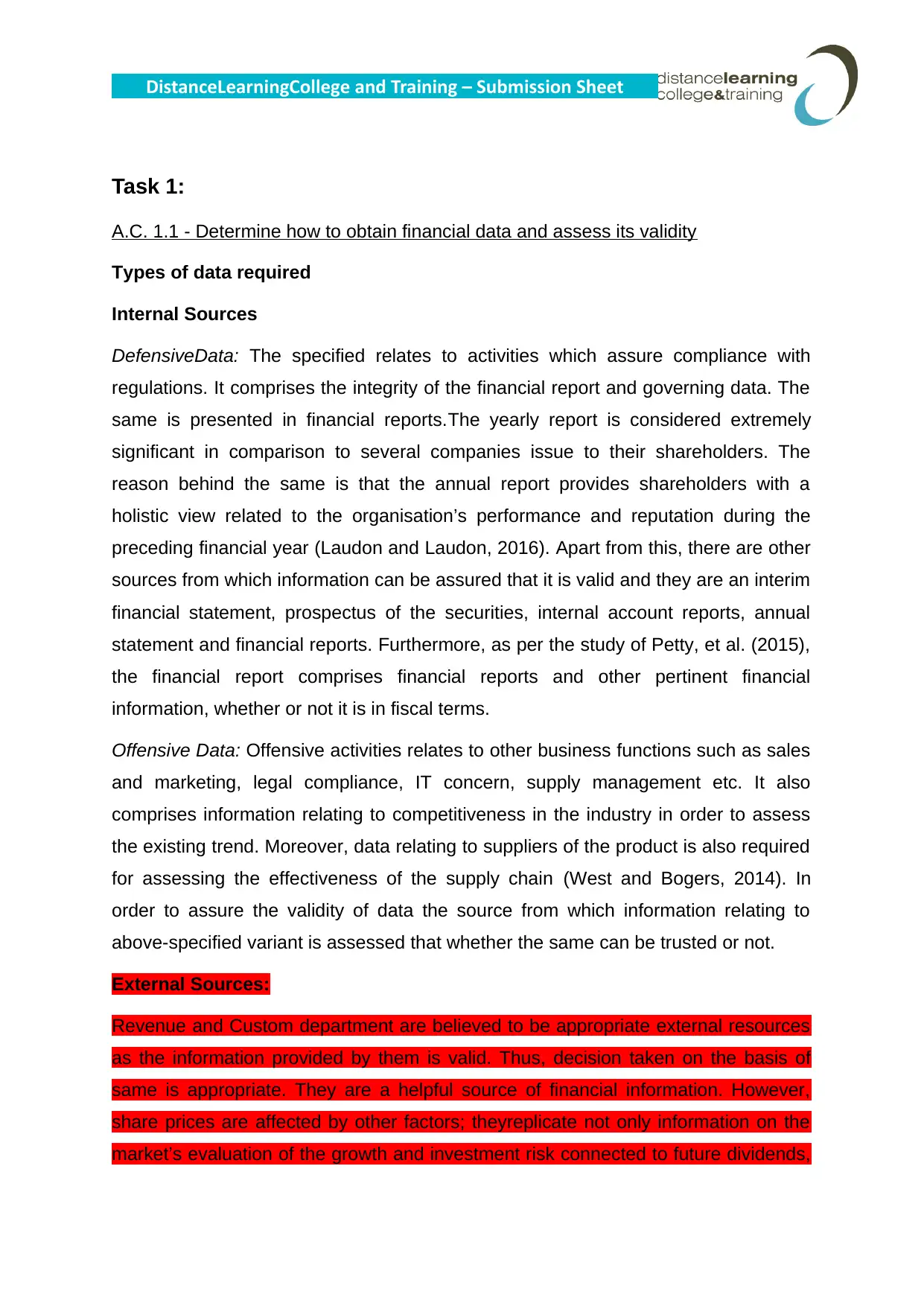
DistanceLearningCollege and Training – Submission Sheet
Task 1:
A.C. 1.1 - Determine how to obtain financial data and assess its validity
Types of data required
Internal Sources
DefensiveData: The specified relates to activities which assure compliance with
regulations. It comprises the integrity of the financial report and governing data. The
same is presented in financial reports.The yearly report is considered extremely
significant in comparison to several companies issue to their shareholders. The
reason behind the same is that the annual report provides shareholders with a
holistic view related to the organisation’s performance and reputation during the
preceding financial year (Laudon and Laudon, 2016). Apart from this, there are other
sources from which information can be assured that it is valid and they are an interim
financial statement, prospectus of the securities, internal account reports, annual
statement and financial reports. Furthermore, as per the study of Petty, et al. (2015),
the financial report comprises financial reports and other pertinent financial
information, whether or not it is in fiscal terms.
Offensive Data: Offensive activities relates to other business functions such as sales
and marketing, legal compliance, IT concern, supply management etc. It also
comprises information relating to competitiveness in the industry in order to assess
the existing trend. Moreover, data relating to suppliers of the product is also required
for assessing the effectiveness of the supply chain (West and Bogers, 2014). In
order to assure the validity of data the source from which information relating to
above-specified variant is assessed that whether the same can be trusted or not.
External Sources:
Revenue and Custom department are believed to be appropriate external resources
as the information provided by them is valid. Thus, decision taken on the basis of
same is appropriate. They are a helpful source of financial information. However,
share prices are affected by other factors; theyreplicate not only information on the
market’s evaluation of the growth and investment risk connected to future dividends,
Task 1:
A.C. 1.1 - Determine how to obtain financial data and assess its validity
Types of data required
Internal Sources
DefensiveData: The specified relates to activities which assure compliance with
regulations. It comprises the integrity of the financial report and governing data. The
same is presented in financial reports.The yearly report is considered extremely
significant in comparison to several companies issue to their shareholders. The
reason behind the same is that the annual report provides shareholders with a
holistic view related to the organisation’s performance and reputation during the
preceding financial year (Laudon and Laudon, 2016). Apart from this, there are other
sources from which information can be assured that it is valid and they are an interim
financial statement, prospectus of the securities, internal account reports, annual
statement and financial reports. Furthermore, as per the study of Petty, et al. (2015),
the financial report comprises financial reports and other pertinent financial
information, whether or not it is in fiscal terms.
Offensive Data: Offensive activities relates to other business functions such as sales
and marketing, legal compliance, IT concern, supply management etc. It also
comprises information relating to competitiveness in the industry in order to assess
the existing trend. Moreover, data relating to suppliers of the product is also required
for assessing the effectiveness of the supply chain (West and Bogers, 2014). In
order to assure the validity of data the source from which information relating to
above-specified variant is assessed that whether the same can be trusted or not.
External Sources:
Revenue and Custom department are believed to be appropriate external resources
as the information provided by them is valid. Thus, decision taken on the basis of
same is appropriate. They are a helpful source of financial information. However,
share prices are affected by other factors; theyreplicate not only information on the
market’s evaluation of the growth and investment risk connected to future dividends,
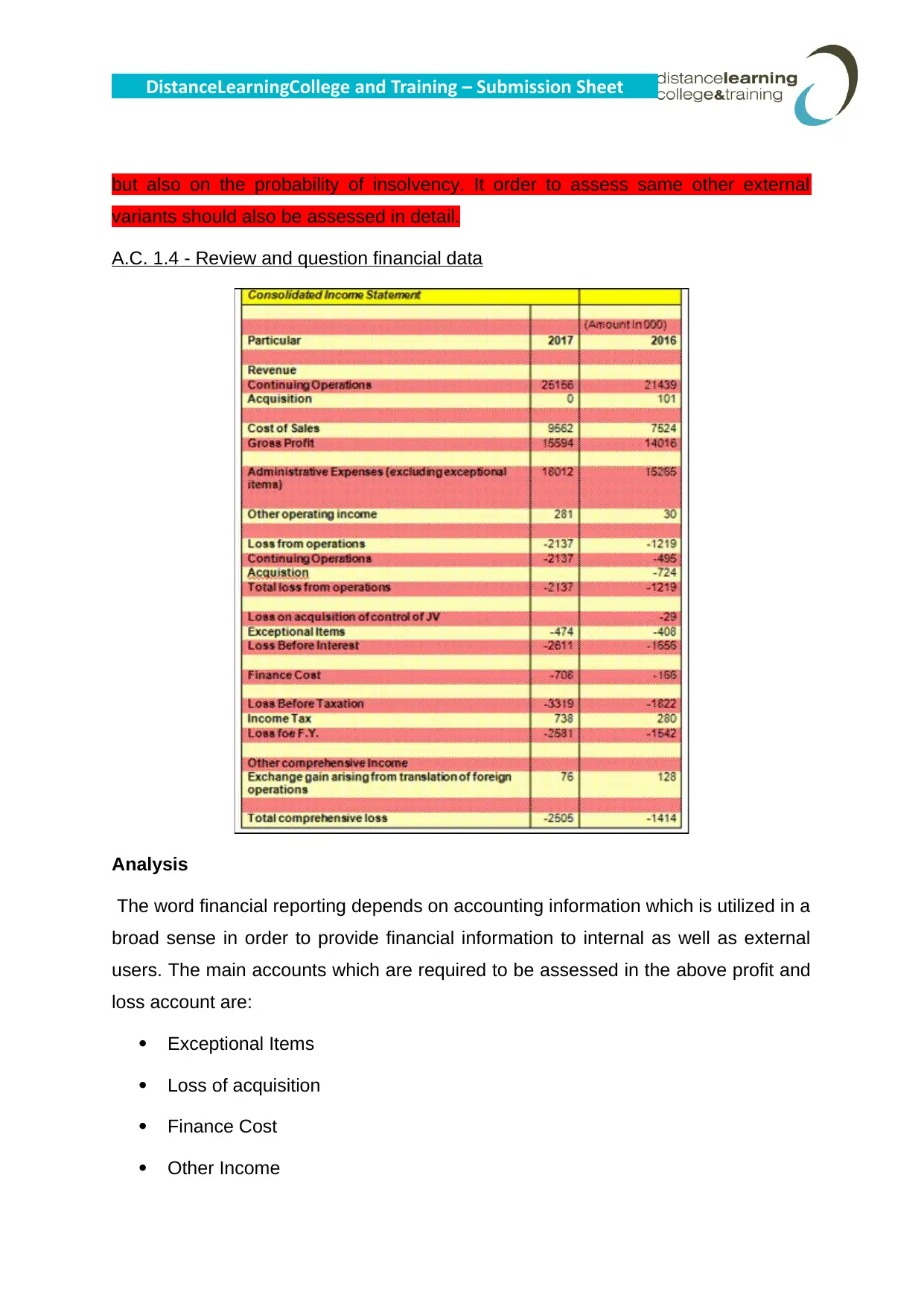
DistanceLearningCollege and Training – Submission Sheet
but also on the probability of insolvency. It order to assess same other external
variants should also be assessed in detail.
A.C. 1.4 - Review and question financial data
Analysis
The word financial reporting depends on accounting information which is utilized in a
broad sense in order to provide financial information to internal as well as external
users. The main accounts which are required to be assessed in the above profit and
loss account are:
Exceptional Items
Loss of acquisition
Finance Cost
Other Income
but also on the probability of insolvency. It order to assess same other external
variants should also be assessed in detail.
A.C. 1.4 - Review and question financial data
Analysis
The word financial reporting depends on accounting information which is utilized in a
broad sense in order to provide financial information to internal as well as external
users. The main accounts which are required to be assessed in the above profit and
loss account are:
Exceptional Items
Loss of acquisition
Finance Cost
Other Income
Paraphrase This Document
Need a fresh take? Get an instant paraphrase of this document with our AI Paraphraser
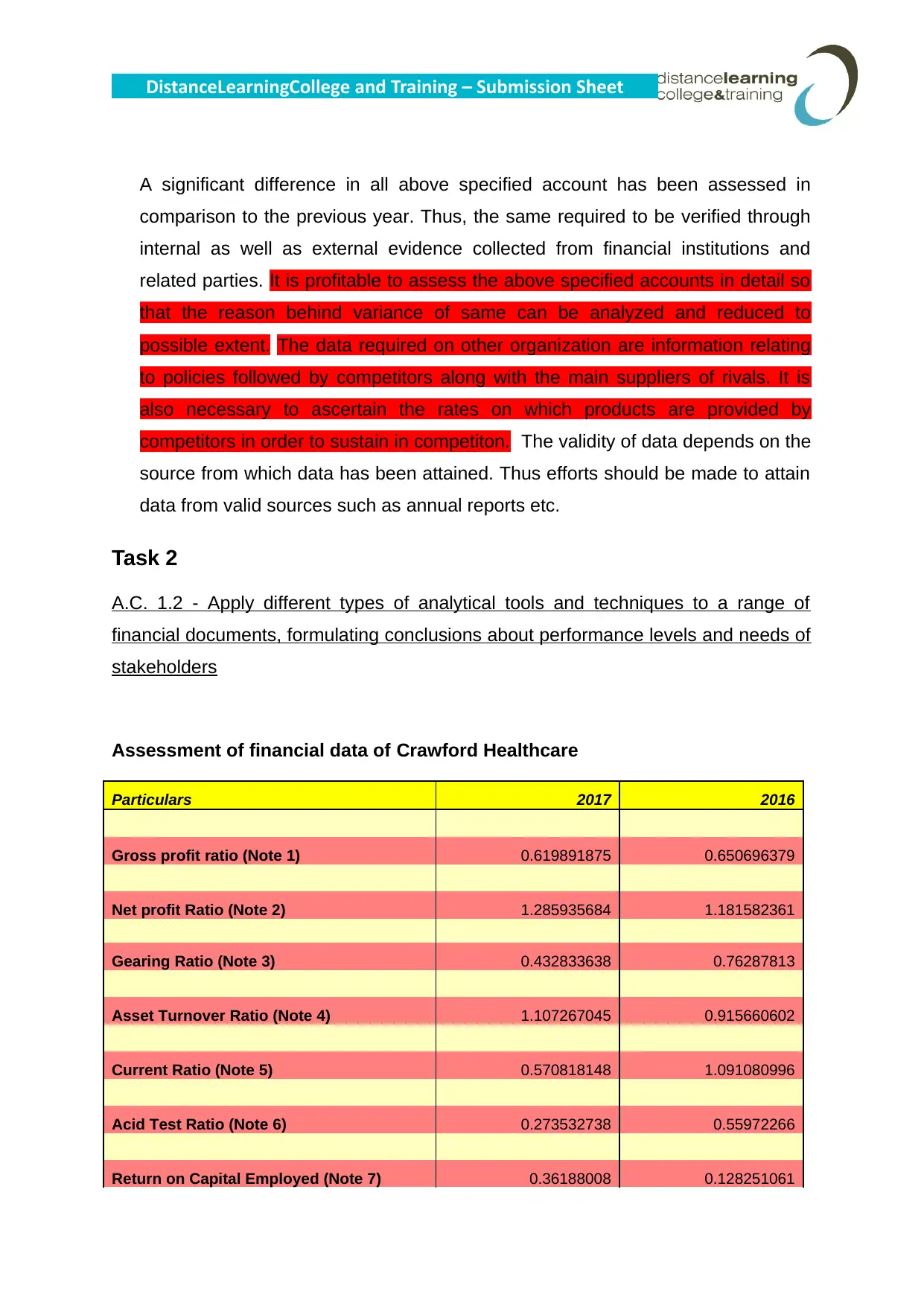
DistanceLearningCollege and Training – Submission Sheet
A significant difference in all above specified account has been assessed in
comparison to the previous year. Thus, the same required to be verified through
internal as well as external evidence collected from financial institutions and
related parties. It is profitable to assess the above specified accounts in detail so
that the reason behind variance of same can be analyzed and reduced to
possible extent. The data required on other organization are information relating
to policies followed by competitors along with the main suppliers of rivals. It is
also necessary to ascertain the rates on which products are provided by
competitors in order to sustain in competiton. The validity of data depends on the
source from which data has been attained. Thus efforts should be made to attain
data from valid sources such as annual reports etc.
Task 2
A.C. 1.2 - Apply different types of analytical tools and techniques to a range of
financial documents, formulating conclusions about performance levels and needs of
stakeholders
Assessment of financial data of Crawford Healthcare
Particulars 2017 2016
Gross profit ratio (Note 1) 0.619891875 0.650696379
Net profit Ratio (Note 2) 1.285935684 1.181582361
Gearing Ratio (Note 3) 0.432833638 0.76287813
Asset Turnover Ratio (Note 4) 1.107267045 0.915660602
Current Ratio (Note 5) 0.570818148 1.091080996
Acid Test Ratio (Note 6) 0.273532738 0.55972266
Return on Capital Employed (Note 7) 0.36188008 0.128251061
A significant difference in all above specified account has been assessed in
comparison to the previous year. Thus, the same required to be verified through
internal as well as external evidence collected from financial institutions and
related parties. It is profitable to assess the above specified accounts in detail so
that the reason behind variance of same can be analyzed and reduced to
possible extent. The data required on other organization are information relating
to policies followed by competitors along with the main suppliers of rivals. It is
also necessary to ascertain the rates on which products are provided by
competitors in order to sustain in competiton. The validity of data depends on the
source from which data has been attained. Thus efforts should be made to attain
data from valid sources such as annual reports etc.
Task 2
A.C. 1.2 - Apply different types of analytical tools and techniques to a range of
financial documents, formulating conclusions about performance levels and needs of
stakeholders
Assessment of financial data of Crawford Healthcare
Particulars 2017 2016
Gross profit ratio (Note 1) 0.619891875 0.650696379
Net profit Ratio (Note 2) 1.285935684 1.181582361
Gearing Ratio (Note 3) 0.432833638 0.76287813
Asset Turnover Ratio (Note 4) 1.107267045 0.915660602
Current Ratio (Note 5) 0.570818148 1.091080996
Acid Test Ratio (Note 6) 0.273532738 0.55972266
Return on Capital Employed (Note 7) 0.36188008 0.128251061
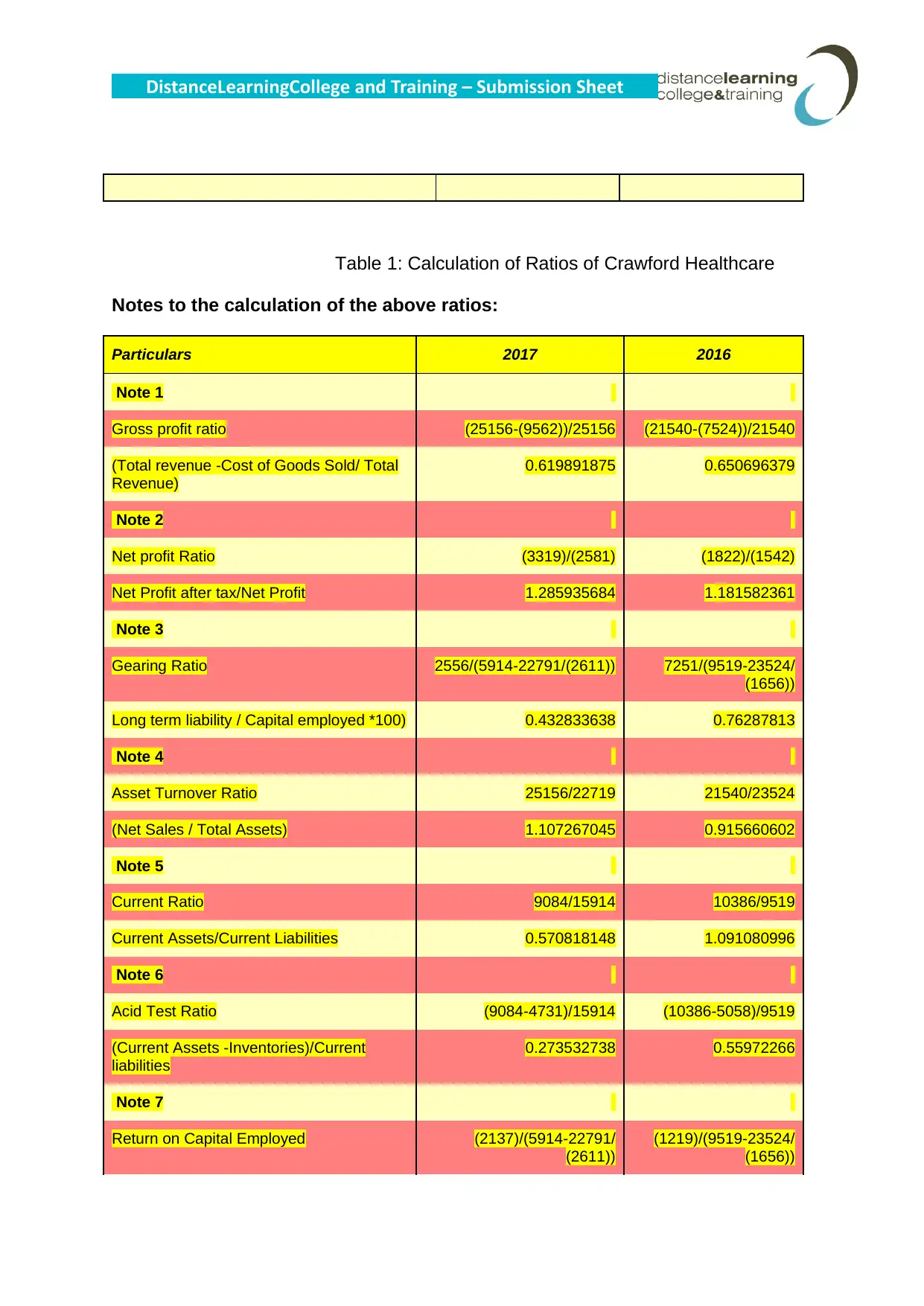
DistanceLearningCollege and Training – Submission Sheet
Table 1: Calculation of Ratios of Crawford Healthcare
Notes to the calculation of the above ratios:
Particulars 2017 2016
Note 1
Gross profit ratio (25156-(9562))/25156 (21540-(7524))/21540
(Total revenue -Cost of Goods Sold/ Total
Revenue)
0.619891875 0.650696379
Note 2
Net profit Ratio (3319)/(2581) (1822)/(1542)
Net Profit after tax/Net Profit 1.285935684 1.181582361
Note 3
Gearing Ratio 2556/(5914-22791/(2611)) 7251/(9519-23524/
(1656))
Long term liability / Capital employed *100) 0.432833638 0.76287813
Note 4
Asset Turnover Ratio 25156/22719 21540/23524
(Net Sales / Total Assets) 1.107267045 0.915660602
Note 5
Current Ratio 9084/15914 10386/9519
Current Assets/Current Liabilities 0.570818148 1.091080996
Note 6
Acid Test Ratio (9084-4731)/15914 (10386-5058)/9519
(Current Assets -Inventories)/Current
liabilities
0.273532738 0.55972266
Note 7
Return on Capital Employed (2137)/(5914-22791/
(2611))
(1219)/(9519-23524/
(1656))
Table 1: Calculation of Ratios of Crawford Healthcare
Notes to the calculation of the above ratios:
Particulars 2017 2016
Note 1
Gross profit ratio (25156-(9562))/25156 (21540-(7524))/21540
(Total revenue -Cost of Goods Sold/ Total
Revenue)
0.619891875 0.650696379
Note 2
Net profit Ratio (3319)/(2581) (1822)/(1542)
Net Profit after tax/Net Profit 1.285935684 1.181582361
Note 3
Gearing Ratio 2556/(5914-22791/(2611)) 7251/(9519-23524/
(1656))
Long term liability / Capital employed *100) 0.432833638 0.76287813
Note 4
Asset Turnover Ratio 25156/22719 21540/23524
(Net Sales / Total Assets) 1.107267045 0.915660602
Note 5
Current Ratio 9084/15914 10386/9519
Current Assets/Current Liabilities 0.570818148 1.091080996
Note 6
Acid Test Ratio (9084-4731)/15914 (10386-5058)/9519
(Current Assets -Inventories)/Current
liabilities
0.273532738 0.55972266
Note 7
Return on Capital Employed (2137)/(5914-22791/
(2611))
(1219)/(9519-23524/
(1656))
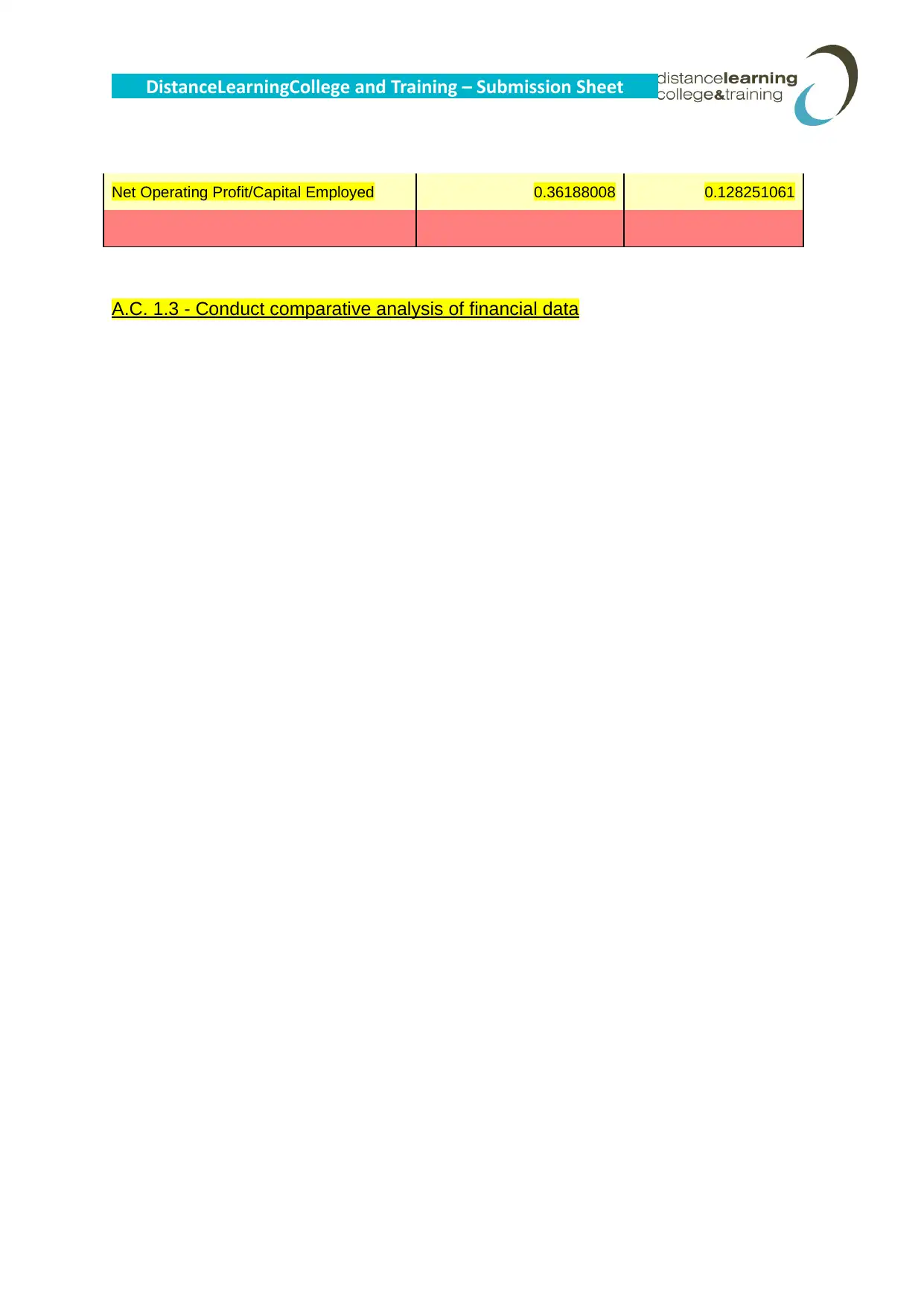
DistanceLearningCollege and Training – Submission Sheet
Net Operating Profit/Capital Employed 0.36188008 0.128251061
A.C. 1.3 - Conduct comparative analysis of financial data
Net Operating Profit/Capital Employed 0.36188008 0.128251061
A.C. 1.3 - Conduct comparative analysis of financial data
Secure Best Marks with AI Grader
Need help grading? Try our AI Grader for instant feedback on your assignments.
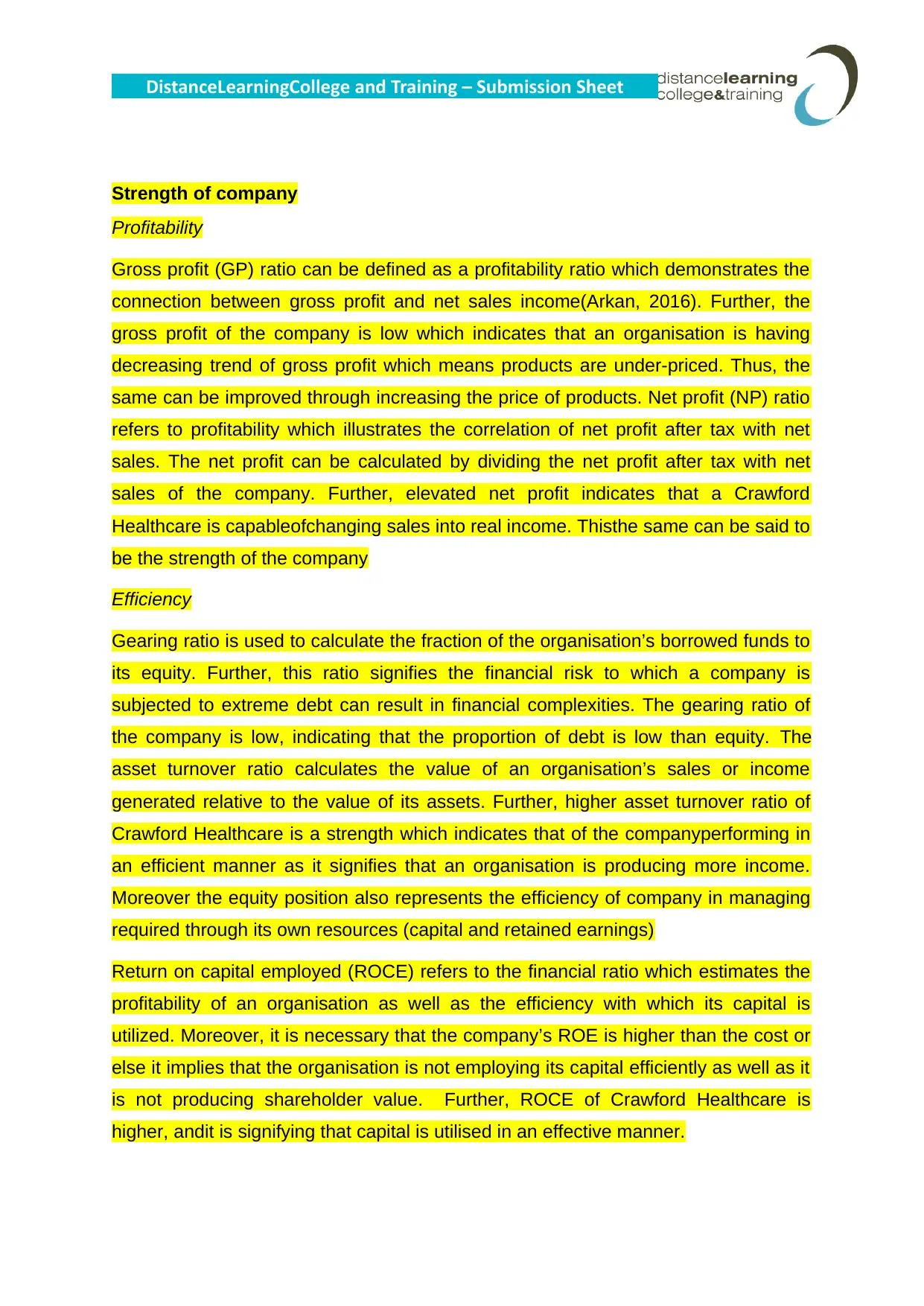
DistanceLearningCollege and Training – Submission Sheet
Strength of company
Profitability
Gross profit (GP) ratio can be defined as a profitability ratio which demonstrates the
connection between gross profit and net sales income(Arkan, 2016). Further, the
gross profit of the company is low which indicates that an organisation is having
decreasing trend of gross profit which means products are under-priced. Thus, the
same can be improved through increasing the price of products. Net profit (NP) ratio
refers to profitability which illustrates the correlation of net profit after tax with net
sales. The net profit can be calculated by dividing the net profit after tax with net
sales of the company. Further, elevated net profit indicates that a Crawford
Healthcare is capableofchanging sales into real income. Thisthe same can be said to
be the strength of the company
Efficiency
Gearing ratio is used to calculate the fraction of the organisation’s borrowed funds to
its equity. Further, this ratio signifies the financial risk to which a company is
subjected to extreme debt can result in financial complexities. The gearing ratio of
the company is low, indicating that the proportion of debt is low than equity. The
asset turnover ratio calculates the value of an organisation’s sales or income
generated relative to the value of its assets. Further, higher asset turnover ratio of
Crawford Healthcare is a strength which indicates that of the companyperforming in
an efficient manner as it signifies that an organisation is producing more income.
Moreover the equity position also represents the efficiency of company in managing
required through its own resources (capital and retained earnings)
Return on capital employed (ROCE) refers to the financial ratio which estimates the
profitability of an organisation as well as the efficiency with which its capital is
utilized. Moreover, it is necessary that the company’s ROE is higher than the cost or
else it implies that the organisation is not employing its capital efficiently as well as it
is not producing shareholder value. Further, ROCE of Crawford Healthcare is
higher, andit is signifying that capital is utilised in an effective manner.
Strength of company
Profitability
Gross profit (GP) ratio can be defined as a profitability ratio which demonstrates the
connection between gross profit and net sales income(Arkan, 2016). Further, the
gross profit of the company is low which indicates that an organisation is having
decreasing trend of gross profit which means products are under-priced. Thus, the
same can be improved through increasing the price of products. Net profit (NP) ratio
refers to profitability which illustrates the correlation of net profit after tax with net
sales. The net profit can be calculated by dividing the net profit after tax with net
sales of the company. Further, elevated net profit indicates that a Crawford
Healthcare is capableofchanging sales into real income. Thisthe same can be said to
be the strength of the company
Efficiency
Gearing ratio is used to calculate the fraction of the organisation’s borrowed funds to
its equity. Further, this ratio signifies the financial risk to which a company is
subjected to extreme debt can result in financial complexities. The gearing ratio of
the company is low, indicating that the proportion of debt is low than equity. The
asset turnover ratio calculates the value of an organisation’s sales or income
generated relative to the value of its assets. Further, higher asset turnover ratio of
Crawford Healthcare is a strength which indicates that of the companyperforming in
an efficient manner as it signifies that an organisation is producing more income.
Moreover the equity position also represents the efficiency of company in managing
required through its own resources (capital and retained earnings)
Return on capital employed (ROCE) refers to the financial ratio which estimates the
profitability of an organisation as well as the efficiency with which its capital is
utilized. Moreover, it is necessary that the company’s ROE is higher than the cost or
else it implies that the organisation is not employing its capital efficiently as well as it
is not producing shareholder value. Further, ROCE of Crawford Healthcare is
higher, andit is signifying that capital is utilised in an effective manner.
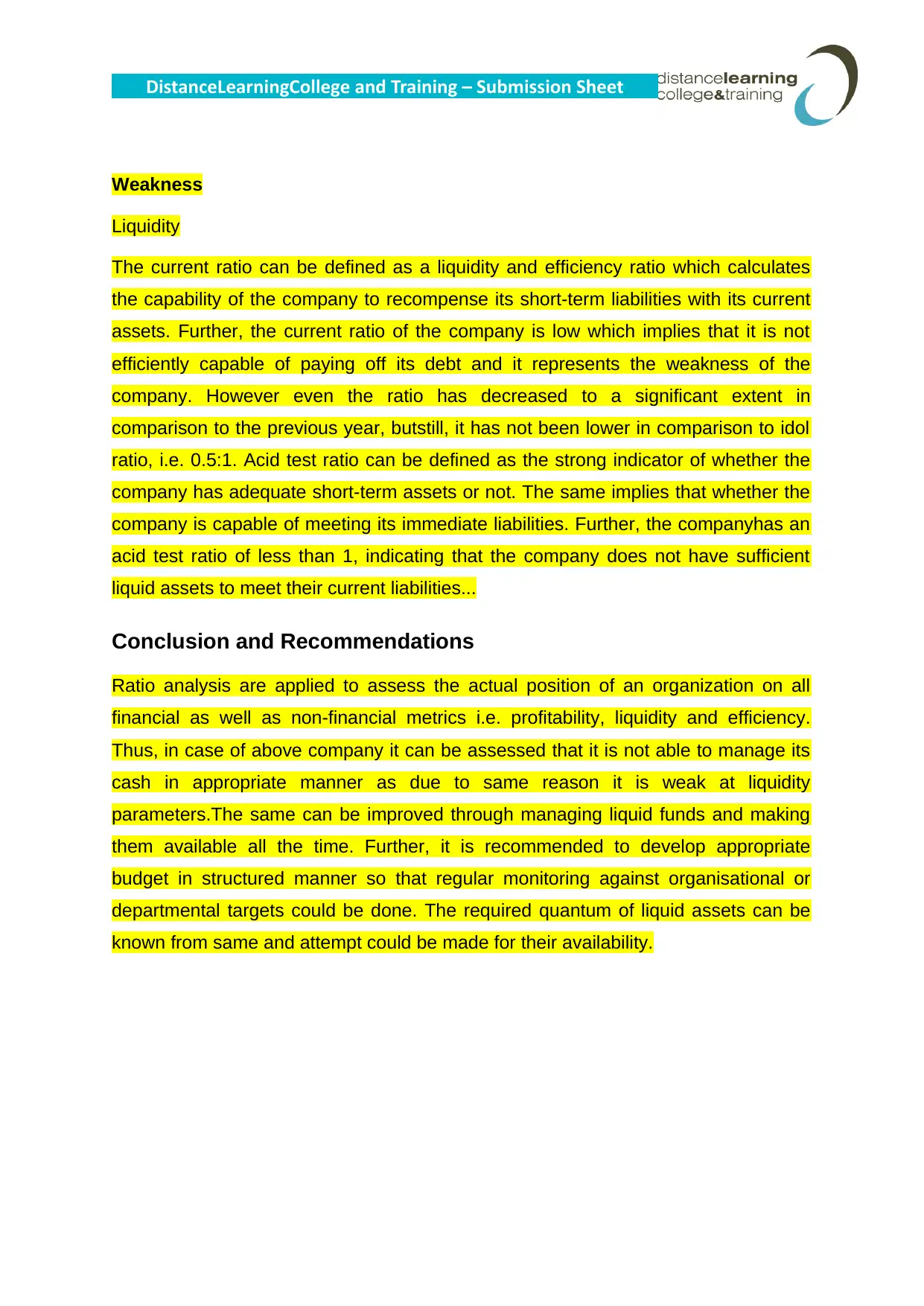
DistanceLearningCollege and Training – Submission Sheet
Weakness
Liquidity
The current ratio can be defined as a liquidity and efficiency ratio which calculates
the capability of the company to recompense its short-term liabilities with its current
assets. Further, the current ratio of the company is low which implies that it is not
efficiently capable of paying off its debt and it represents the weakness of the
company. However even the ratio has decreased to a significant extent in
comparison to the previous year, butstill, it has not been lower in comparison to idol
ratio, i.e. 0.5:1. Acid test ratio can be defined as the strong indicator of whether the
company has adequate short-term assets or not. The same implies that whether the
company is capable of meeting its immediate liabilities. Further, the companyhas an
acid test ratio of less than 1, indicating that the company does not have sufficient
liquid assets to meet their current liabilities...
Conclusion and Recommendations
Ratio analysis are applied to assess the actual position of an organization on all
financial as well as non-financial metrics i.e. profitability, liquidity and efficiency.
Thus, in case of above company it can be assessed that it is not able to manage its
cash in appropriate manner as due to same reason it is weak at liquidity
parameters.The same can be improved through managing liquid funds and making
them available all the time. Further, it is recommended to develop appropriate
budget in structured manner so that regular monitoring against organisational or
departmental targets could be done. The required quantum of liquid assets can be
known from same and attempt could be made for their availability.
Weakness
Liquidity
The current ratio can be defined as a liquidity and efficiency ratio which calculates
the capability of the company to recompense its short-term liabilities with its current
assets. Further, the current ratio of the company is low which implies that it is not
efficiently capable of paying off its debt and it represents the weakness of the
company. However even the ratio has decreased to a significant extent in
comparison to the previous year, butstill, it has not been lower in comparison to idol
ratio, i.e. 0.5:1. Acid test ratio can be defined as the strong indicator of whether the
company has adequate short-term assets or not. The same implies that whether the
company is capable of meeting its immediate liabilities. Further, the companyhas an
acid test ratio of less than 1, indicating that the company does not have sufficient
liquid assets to meet their current liabilities...
Conclusion and Recommendations
Ratio analysis are applied to assess the actual position of an organization on all
financial as well as non-financial metrics i.e. profitability, liquidity and efficiency.
Thus, in case of above company it can be assessed that it is not able to manage its
cash in appropriate manner as due to same reason it is weak at liquidity
parameters.The same can be improved through managing liquid funds and making
them available all the time. Further, it is recommended to develop appropriate
budget in structured manner so that regular monitoring against organisational or
departmental targets could be done. The required quantum of liquid assets can be
known from same and attempt could be made for their availability.
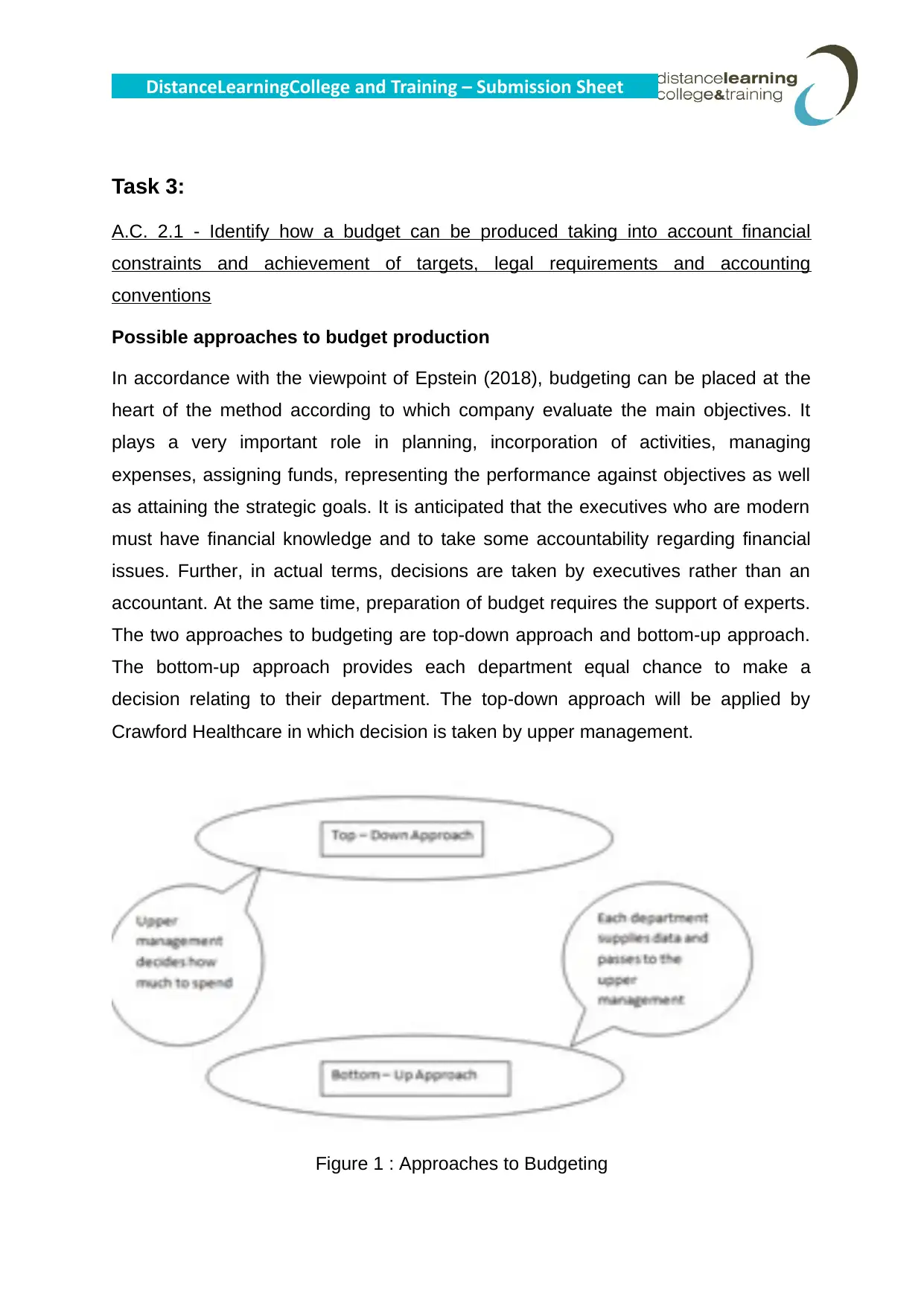
DistanceLearningCollege and Training – Submission Sheet
Task 3:
A.C. 2.1 - Identify how a budget can be produced taking into account financial
constraints and achievement of targets, legal requirements and accounting
conventions
Possible approaches to budget production
In accordance with the viewpoint of Epstein (2018), budgeting can be placed at the
heart of the method according to which company evaluate the main objectives. It
plays a very important role in planning, incorporation of activities, managing
expenses, assigning funds, representing the performance against objectives as well
as attaining the strategic goals. It is anticipated that the executives who are modern
must have financial knowledge and to take some accountability regarding financial
issues. Further, in actual terms, decisions are taken by executives rather than an
accountant. At the same time, preparation of budget requires the support of experts.
The two approaches to budgeting are top-down approach and bottom-up approach.
The bottom-up approach provides each department equal chance to make a
decision relating to their department. The top-down approach will be applied by
Crawford Healthcare in which decision is taken by upper management.
Figure 1 : Approaches to Budgeting
Task 3:
A.C. 2.1 - Identify how a budget can be produced taking into account financial
constraints and achievement of targets, legal requirements and accounting
conventions
Possible approaches to budget production
In accordance with the viewpoint of Epstein (2018), budgeting can be placed at the
heart of the method according to which company evaluate the main objectives. It
plays a very important role in planning, incorporation of activities, managing
expenses, assigning funds, representing the performance against objectives as well
as attaining the strategic goals. It is anticipated that the executives who are modern
must have financial knowledge and to take some accountability regarding financial
issues. Further, in actual terms, decisions are taken by executives rather than an
accountant. At the same time, preparation of budget requires the support of experts.
The two approaches to budgeting are top-down approach and bottom-up approach.
The bottom-up approach provides each department equal chance to make a
decision relating to their department. The top-down approach will be applied by
Crawford Healthcare in which decision is taken by upper management.
Figure 1 : Approaches to Budgeting
Paraphrase This Document
Need a fresh take? Get an instant paraphrase of this document with our AI Paraphraser
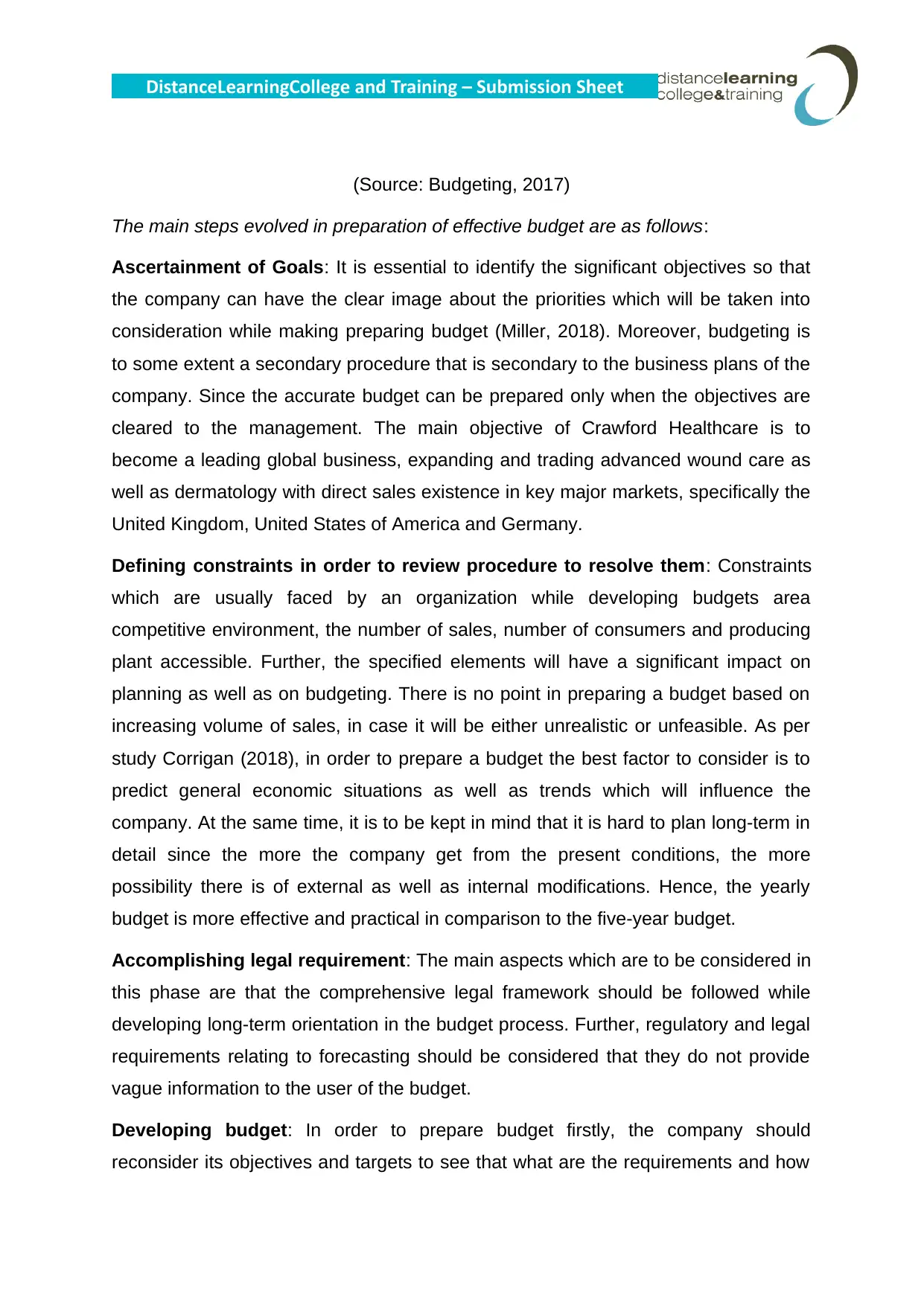
DistanceLearningCollege and Training – Submission Sheet
(Source: Budgeting, 2017)
The main steps evolved in preparation of effective budget are as follows:
Ascertainment of Goals: It is essential to identify the significant objectives so that
the company can have the clear image about the priorities which will be taken into
consideration while making preparing budget (Miller, 2018). Moreover, budgeting is
to some extent a secondary procedure that is secondary to the business plans of the
company. Since the accurate budget can be prepared only when the objectives are
cleared to the management. The main objective of Crawford Healthcare is to
become a leading global business, expanding and trading advanced wound care as
well as dermatology with direct sales existence in key major markets, specifically the
United Kingdom, United States of America and Germany.
Defining constraints in order to review procedure to resolve them: Constraints
which are usually faced by an organization while developing budgets area
competitive environment, the number of sales, number of consumers and producing
plant accessible. Further, the specified elements will have a significant impact on
planning as well as on budgeting. There is no point in preparing a budget based on
increasing volume of sales, in case it will be either unrealistic or unfeasible. As per
study Corrigan (2018), in order to prepare a budget the best factor to consider is to
predict general economic situations as well as trends which will influence the
company. At the same time, it is to be kept in mind that it is hard to plan long-term in
detail since the more the company get from the present conditions, the more
possibility there is of external as well as internal modifications. Hence, the yearly
budget is more effective and practical in comparison to the five-year budget.
Accomplishing legal requirement: The main aspects which are to be considered in
this phase are that the comprehensive legal framework should be followed while
developing long-term orientation in the budget process. Further, regulatory and legal
requirements relating to forecasting should be considered that they do not provide
vague information to the user of the budget.
Developing budget: In order to prepare budget firstly, the company should
reconsider its objectives and targets to see that what are the requirements and how
(Source: Budgeting, 2017)
The main steps evolved in preparation of effective budget are as follows:
Ascertainment of Goals: It is essential to identify the significant objectives so that
the company can have the clear image about the priorities which will be taken into
consideration while making preparing budget (Miller, 2018). Moreover, budgeting is
to some extent a secondary procedure that is secondary to the business plans of the
company. Since the accurate budget can be prepared only when the objectives are
cleared to the management. The main objective of Crawford Healthcare is to
become a leading global business, expanding and trading advanced wound care as
well as dermatology with direct sales existence in key major markets, specifically the
United Kingdom, United States of America and Germany.
Defining constraints in order to review procedure to resolve them: Constraints
which are usually faced by an organization while developing budgets area
competitive environment, the number of sales, number of consumers and producing
plant accessible. Further, the specified elements will have a significant impact on
planning as well as on budgeting. There is no point in preparing a budget based on
increasing volume of sales, in case it will be either unrealistic or unfeasible. As per
study Corrigan (2018), in order to prepare a budget the best factor to consider is to
predict general economic situations as well as trends which will influence the
company. At the same time, it is to be kept in mind that it is hard to plan long-term in
detail since the more the company get from the present conditions, the more
possibility there is of external as well as internal modifications. Hence, the yearly
budget is more effective and practical in comparison to the five-year budget.
Accomplishing legal requirement: The main aspects which are to be considered in
this phase are that the comprehensive legal framework should be followed while
developing long-term orientation in the budget process. Further, regulatory and legal
requirements relating to forecasting should be considered that they do not provide
vague information to the user of the budget.
Developing budget: In order to prepare budget firstly, the company should
reconsider its objectives and targets to see that what are the requirements and how
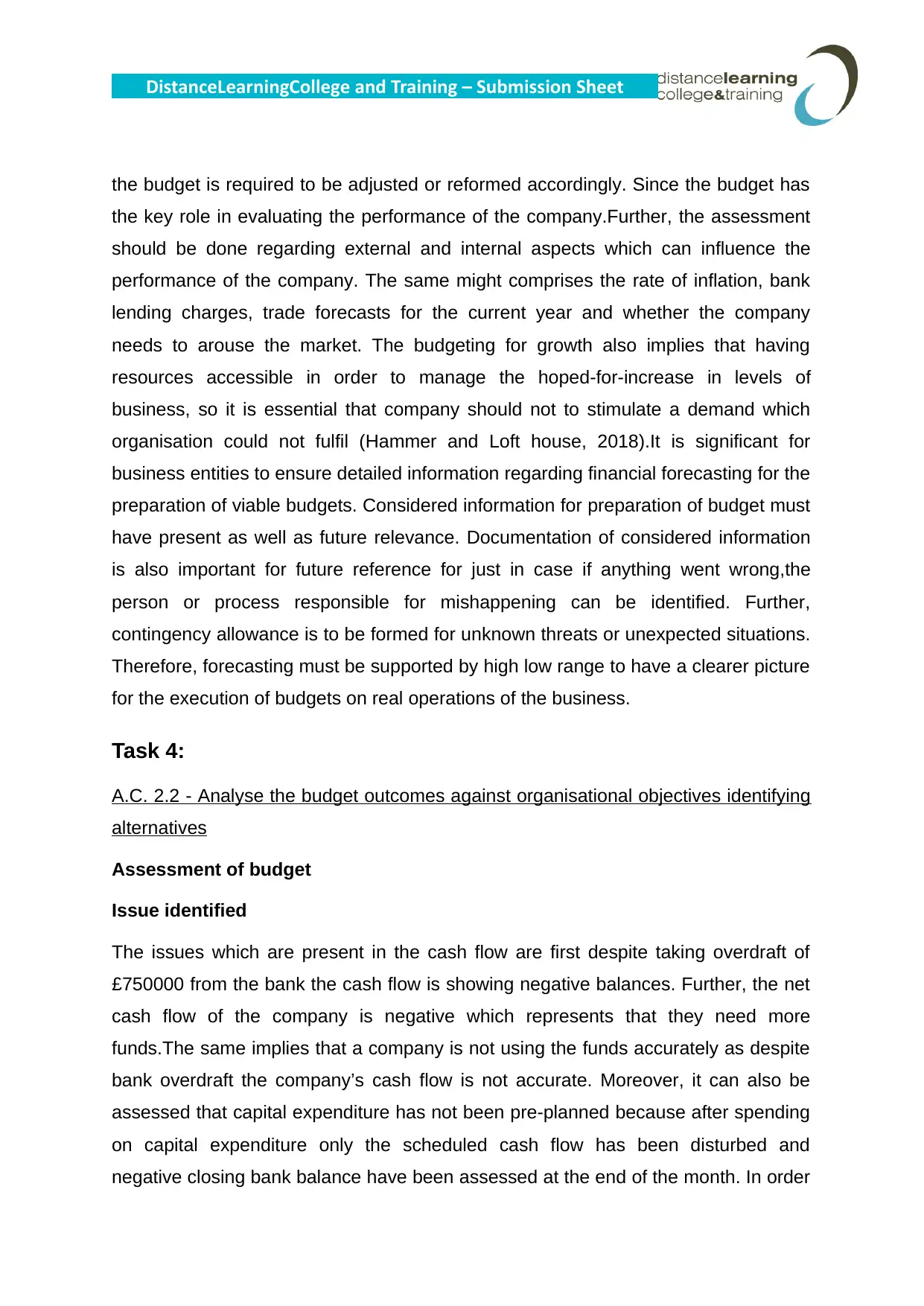
DistanceLearningCollege and Training – Submission Sheet
the budget is required to be adjusted or reformed accordingly. Since the budget has
the key role in evaluating the performance of the company.Further, the assessment
should be done regarding external and internal aspects which can influence the
performance of the company. The same might comprises the rate of inflation, bank
lending charges, trade forecasts for the current year and whether the company
needs to arouse the market. The budgeting for growth also implies that having
resources accessible in order to manage the hoped-for-increase in levels of
business, so it is essential that company should not to stimulate a demand which
organisation could not fulfil (Hammer and Loft house, 2018).It is significant for
business entities to ensure detailed information regarding financial forecasting for the
preparation of viable budgets. Considered information for preparation of budget must
have present as well as future relevance. Documentation of considered information
is also important for future reference for just in case if anything went wrong,the
person or process responsible for mishappening can be identified. Further,
contingency allowance is to be formed for unknown threats or unexpected situations.
Therefore, forecasting must be supported by high low range to have a clearer picture
for the execution of budgets on real operations of the business.
Task 4:
A.C. 2.2 - Analyse the budget outcomes against organisational objectives identifying
alternatives
Assessment of budget
Issue identified
The issues which are present in the cash flow are first despite taking overdraft of
£750000 from the bank the cash flow is showing negative balances. Further, the net
cash flow of the company is negative which represents that they need more
funds.The same implies that a company is not using the funds accurately as despite
bank overdraft the company’s cash flow is not accurate. Moreover, it can also be
assessed that capital expenditure has not been pre-planned because after spending
on capital expenditure only the scheduled cash flow has been disturbed and
negative closing bank balance have been assessed at the end of the month. In order
the budget is required to be adjusted or reformed accordingly. Since the budget has
the key role in evaluating the performance of the company.Further, the assessment
should be done regarding external and internal aspects which can influence the
performance of the company. The same might comprises the rate of inflation, bank
lending charges, trade forecasts for the current year and whether the company
needs to arouse the market. The budgeting for growth also implies that having
resources accessible in order to manage the hoped-for-increase in levels of
business, so it is essential that company should not to stimulate a demand which
organisation could not fulfil (Hammer and Loft house, 2018).It is significant for
business entities to ensure detailed information regarding financial forecasting for the
preparation of viable budgets. Considered information for preparation of budget must
have present as well as future relevance. Documentation of considered information
is also important for future reference for just in case if anything went wrong,the
person or process responsible for mishappening can be identified. Further,
contingency allowance is to be formed for unknown threats or unexpected situations.
Therefore, forecasting must be supported by high low range to have a clearer picture
for the execution of budgets on real operations of the business.
Task 4:
A.C. 2.2 - Analyse the budget outcomes against organisational objectives identifying
alternatives
Assessment of budget
Issue identified
The issues which are present in the cash flow are first despite taking overdraft of
£750000 from the bank the cash flow is showing negative balances. Further, the net
cash flow of the company is negative which represents that they need more
funds.The same implies that a company is not using the funds accurately as despite
bank overdraft the company’s cash flow is not accurate. Moreover, it can also be
assessed that capital expenditure has not been pre-planned because after spending
on capital expenditure only the scheduled cash flow has been disturbed and
negative closing bank balance have been assessed at the end of the month. In order
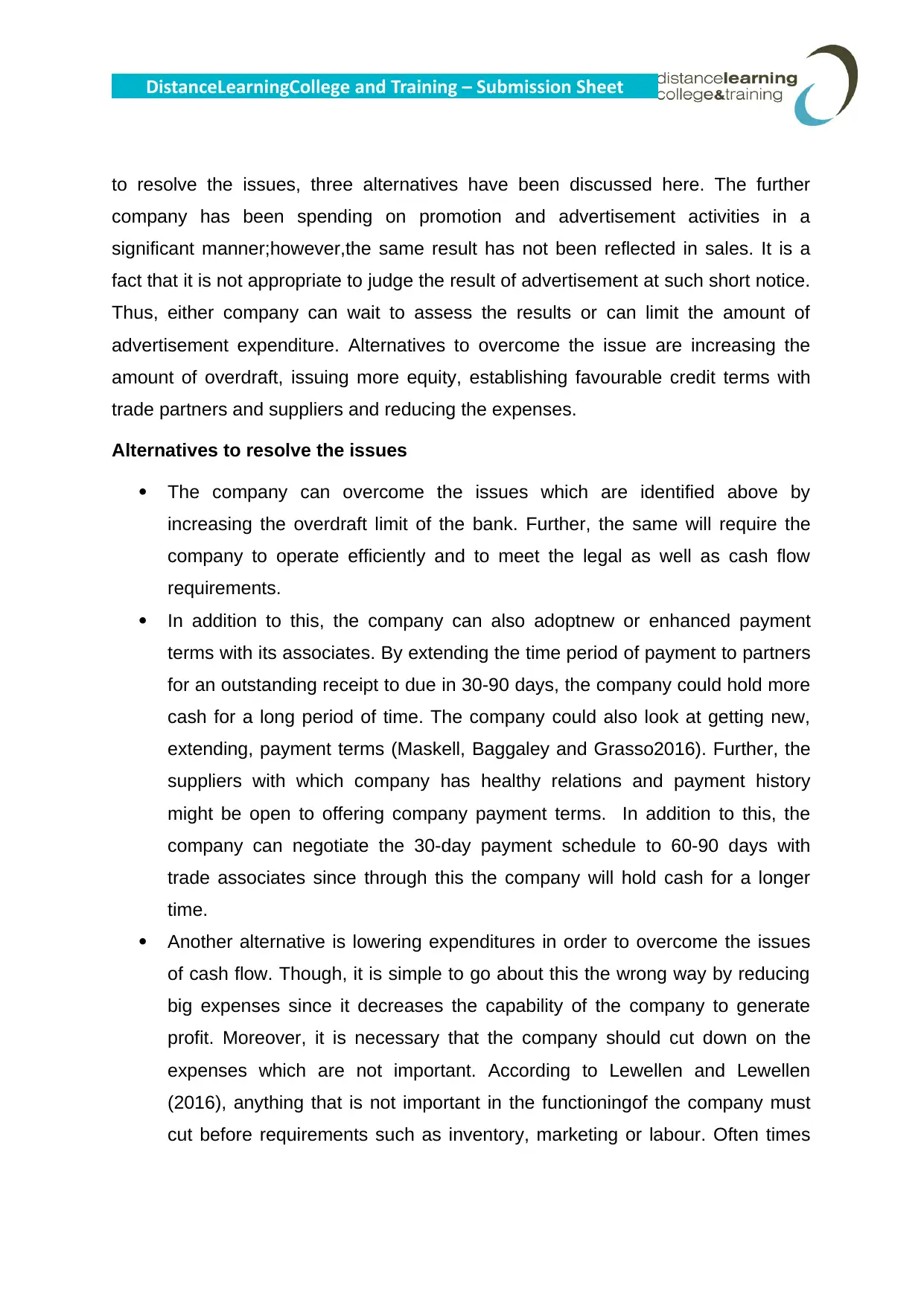
DistanceLearningCollege and Training – Submission Sheet
to resolve the issues, three alternatives have been discussed here. The further
company has been spending on promotion and advertisement activities in a
significant manner;however,the same result has not been reflected in sales. It is a
fact that it is not appropriate to judge the result of advertisement at such short notice.
Thus, either company can wait to assess the results or can limit the amount of
advertisement expenditure. Alternatives to overcome the issue are increasing the
amount of overdraft, issuing more equity, establishing favourable credit terms with
trade partners and suppliers and reducing the expenses.
Alternatives to resolve the issues
The company can overcome the issues which are identified above by
increasing the overdraft limit of the bank. Further, the same will require the
company to operate efficiently and to meet the legal as well as cash flow
requirements.
In addition to this, the company can also adoptnew or enhanced payment
terms with its associates. By extending the time period of payment to partners
for an outstanding receipt to due in 30-90 days, the company could hold more
cash for a long period of time. The company could also look at getting new,
extending, payment terms (Maskell, Baggaley and Grasso2016). Further, the
suppliers with which company has healthy relations and payment history
might be open to offering company payment terms. In addition to this, the
company can negotiate the 30-day payment schedule to 60-90 days with
trade associates since through this the company will hold cash for a longer
time.
Another alternative is lowering expenditures in order to overcome the issues
of cash flow. Though, it is simple to go about this the wrong way by reducing
big expenses since it decreases the capability of the company to generate
profit. Moreover, it is necessary that the company should cut down on the
expenses which are not important. According to Lewellen and Lewellen
(2016), anything that is not important in the functioningof the company must
cut before requirements such as inventory, marketing or labour. Often times
to resolve the issues, three alternatives have been discussed here. The further
company has been spending on promotion and advertisement activities in a
significant manner;however,the same result has not been reflected in sales. It is a
fact that it is not appropriate to judge the result of advertisement at such short notice.
Thus, either company can wait to assess the results or can limit the amount of
advertisement expenditure. Alternatives to overcome the issue are increasing the
amount of overdraft, issuing more equity, establishing favourable credit terms with
trade partners and suppliers and reducing the expenses.
Alternatives to resolve the issues
The company can overcome the issues which are identified above by
increasing the overdraft limit of the bank. Further, the same will require the
company to operate efficiently and to meet the legal as well as cash flow
requirements.
In addition to this, the company can also adoptnew or enhanced payment
terms with its associates. By extending the time period of payment to partners
for an outstanding receipt to due in 30-90 days, the company could hold more
cash for a long period of time. The company could also look at getting new,
extending, payment terms (Maskell, Baggaley and Grasso2016). Further, the
suppliers with which company has healthy relations and payment history
might be open to offering company payment terms. In addition to this, the
company can negotiate the 30-day payment schedule to 60-90 days with
trade associates since through this the company will hold cash for a longer
time.
Another alternative is lowering expenditures in order to overcome the issues
of cash flow. Though, it is simple to go about this the wrong way by reducing
big expenses since it decreases the capability of the company to generate
profit. Moreover, it is necessary that the company should cut down on the
expenses which are not important. According to Lewellen and Lewellen
(2016), anything that is not important in the functioningof the company must
cut before requirements such as inventory, marketing or labour. Often times
Secure Best Marks with AI Grader
Need help grading? Try our AI Grader for instant feedback on your assignments.
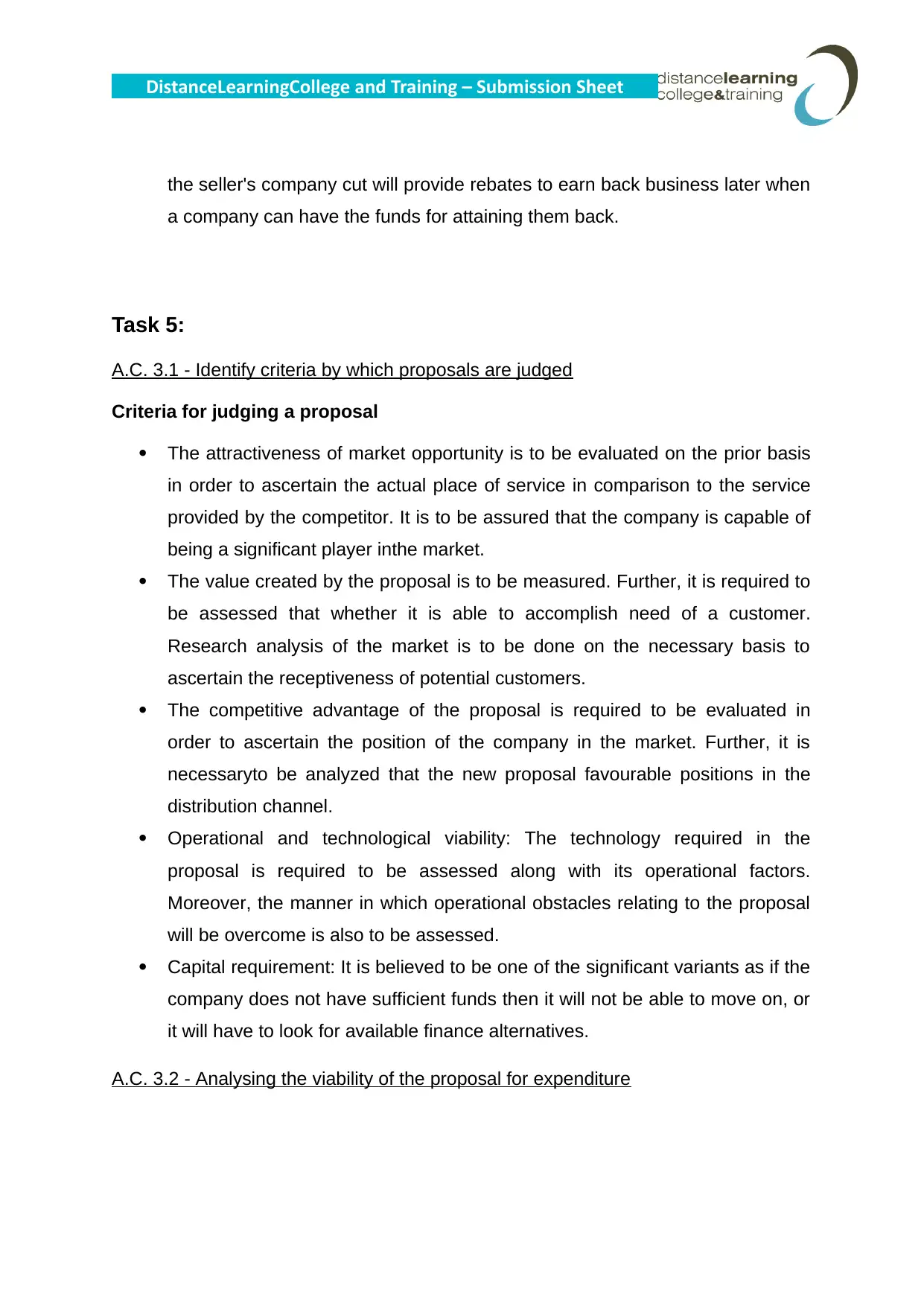
DistanceLearningCollege and Training – Submission Sheet
the seller's company cut will provide rebates to earn back business later when
a company can have the funds for attaining them back.
Task 5:
A.C. 3.1 - Identify criteria by which proposals are judged
Criteria for judging a proposal
The attractiveness of market opportunity is to be evaluated on the prior basis
in order to ascertain the actual place of service in comparison to the service
provided by the competitor. It is to be assured that the company is capable of
being a significant player inthe market.
The value created by the proposal is to be measured. Further, it is required to
be assessed that whether it is able to accomplish need of a customer.
Research analysis of the market is to be done on the necessary basis to
ascertain the receptiveness of potential customers.
The competitive advantage of the proposal is required to be evaluated in
order to ascertain the position of the company in the market. Further, it is
necessaryto be analyzed that the new proposal favourable positions in the
distribution channel.
Operational and technological viability: The technology required in the
proposal is required to be assessed along with its operational factors.
Moreover, the manner in which operational obstacles relating to the proposal
will be overcome is also to be assessed.
Capital requirement: It is believed to be one of the significant variants as if the
company does not have sufficient funds then it will not be able to move on, or
it will have to look for available finance alternatives.
A.C. 3.2 - Analysing the viability of the proposal for expenditure
the seller's company cut will provide rebates to earn back business later when
a company can have the funds for attaining them back.
Task 5:
A.C. 3.1 - Identify criteria by which proposals are judged
Criteria for judging a proposal
The attractiveness of market opportunity is to be evaluated on the prior basis
in order to ascertain the actual place of service in comparison to the service
provided by the competitor. It is to be assured that the company is capable of
being a significant player inthe market.
The value created by the proposal is to be measured. Further, it is required to
be assessed that whether it is able to accomplish need of a customer.
Research analysis of the market is to be done on the necessary basis to
ascertain the receptiveness of potential customers.
The competitive advantage of the proposal is required to be evaluated in
order to ascertain the position of the company in the market. Further, it is
necessaryto be analyzed that the new proposal favourable positions in the
distribution channel.
Operational and technological viability: The technology required in the
proposal is required to be assessed along with its operational factors.
Moreover, the manner in which operational obstacles relating to the proposal
will be overcome is also to be assessed.
Capital requirement: It is believed to be one of the significant variants as if the
company does not have sufficient funds then it will not be able to move on, or
it will have to look for available finance alternatives.
A.C. 3.2 - Analysing the viability of the proposal for expenditure
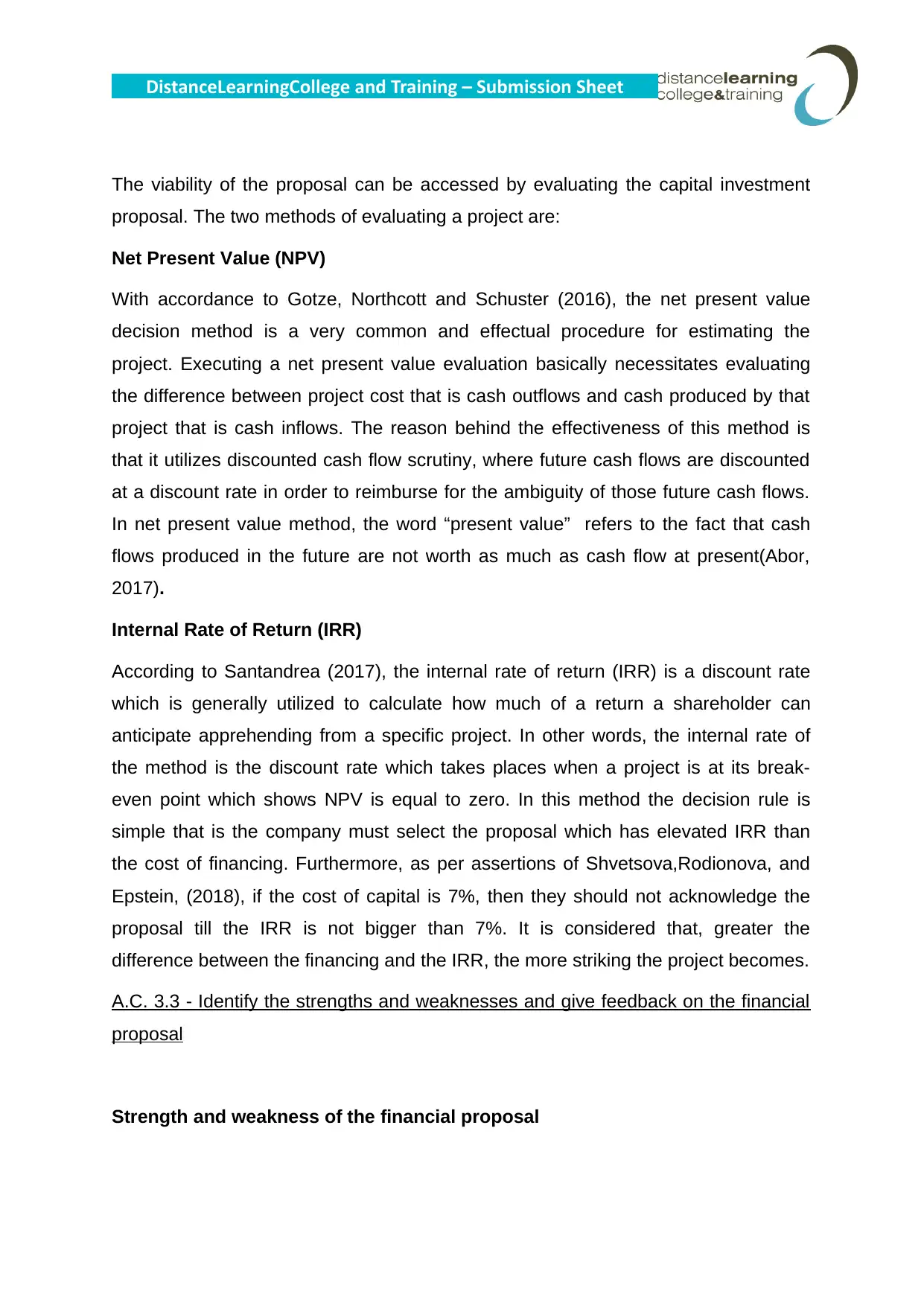
DistanceLearningCollege and Training – Submission Sheet
The viability of the proposal can be accessed by evaluating the capital investment
proposal. The two methods of evaluating a project are:
Net Present Value (NPV)
With accordance to Gotze, Northcott and Schuster (2016), the net present value
decision method is a very common and effectual procedure for estimating the
project. Executing a net present value evaluation basically necessitates evaluating
the difference between project cost that is cash outflows and cash produced by that
project that is cash inflows. The reason behind the effectiveness of this method is
that it utilizes discounted cash flow scrutiny, where future cash flows are discounted
at a discount rate in order to reimburse for the ambiguity of those future cash flows.
In net present value method, the word “present value” refers to the fact that cash
flows produced in the future are not worth as much as cash flow at present(Abor,
2017).
Internal Rate of Return (IRR)
According to Santandrea (2017), the internal rate of return (IRR) is a discount rate
which is generally utilized to calculate how much of a return a shareholder can
anticipate apprehending from a specific project. In other words, the internal rate of
the method is the discount rate which takes places when a project is at its break-
even point which shows NPV is equal to zero. In this method the decision rule is
simple that is the company must select the proposal which has elevated IRR than
the cost of financing. Furthermore, as per assertions of Shvetsova,Rodionova, and
Epstein, (2018), if the cost of capital is 7%, then they should not acknowledge the
proposal till the IRR is not bigger than 7%. It is considered that, greater the
difference between the financing and the IRR, the more striking the project becomes.
A.C. 3.3 - Identify the strengths and weaknesses and give feedback on the financial
proposal
Strength and weakness of the financial proposal
The viability of the proposal can be accessed by evaluating the capital investment
proposal. The two methods of evaluating a project are:
Net Present Value (NPV)
With accordance to Gotze, Northcott and Schuster (2016), the net present value
decision method is a very common and effectual procedure for estimating the
project. Executing a net present value evaluation basically necessitates evaluating
the difference between project cost that is cash outflows and cash produced by that
project that is cash inflows. The reason behind the effectiveness of this method is
that it utilizes discounted cash flow scrutiny, where future cash flows are discounted
at a discount rate in order to reimburse for the ambiguity of those future cash flows.
In net present value method, the word “present value” refers to the fact that cash
flows produced in the future are not worth as much as cash flow at present(Abor,
2017).
Internal Rate of Return (IRR)
According to Santandrea (2017), the internal rate of return (IRR) is a discount rate
which is generally utilized to calculate how much of a return a shareholder can
anticipate apprehending from a specific project. In other words, the internal rate of
the method is the discount rate which takes places when a project is at its break-
even point which shows NPV is equal to zero. In this method the decision rule is
simple that is the company must select the proposal which has elevated IRR than
the cost of financing. Furthermore, as per assertions of Shvetsova,Rodionova, and
Epstein, (2018), if the cost of capital is 7%, then they should not acknowledge the
proposal till the IRR is not bigger than 7%. It is considered that, greater the
difference between the financing and the IRR, the more striking the project becomes.
A.C. 3.3 - Identify the strengths and weaknesses and give feedback on the financial
proposal
Strength and weakness of the financial proposal
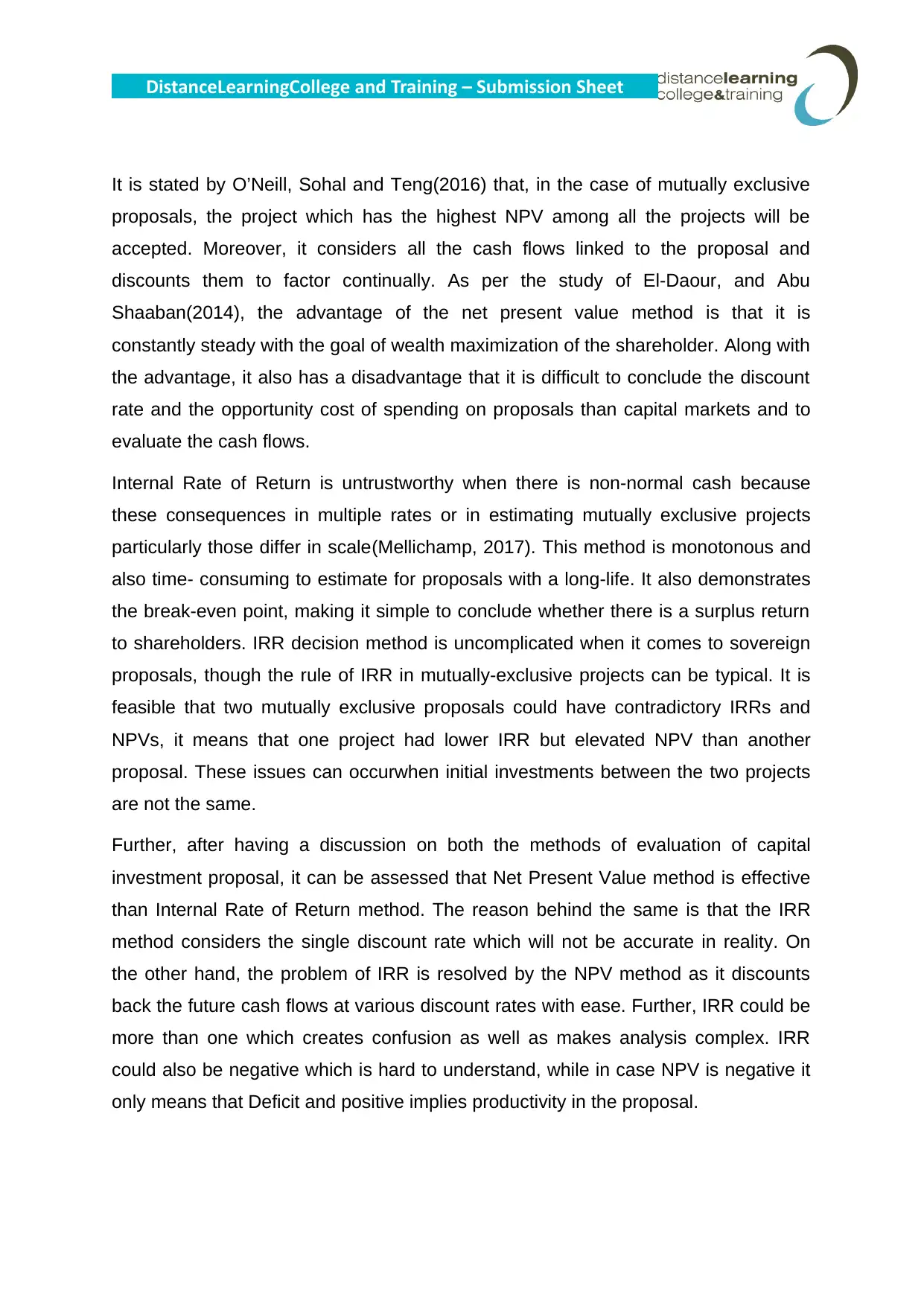
DistanceLearningCollege and Training – Submission Sheet
It is stated by O’Neill, Sohal and Teng(2016) that, in the case of mutually exclusive
proposals, the project which has the highest NPV among all the projects will be
accepted. Moreover, it considers all the cash flows linked to the proposal and
discounts them to factor continually. As per the study of El-Daour, and Abu
Shaaban(2014), the advantage of the net present value method is that it is
constantly steady with the goal of wealth maximization of the shareholder. Along with
the advantage, it also has a disadvantage that it is difficult to conclude the discount
rate and the opportunity cost of spending on proposals than capital markets and to
evaluate the cash flows.
Internal Rate of Return is untrustworthy when there is non-normal cash because
these consequences in multiple rates or in estimating mutually exclusive projects
particularly those differ in scale(Mellichamp, 2017). This method is monotonous and
also time- consuming to estimate for proposals with a long-life. It also demonstrates
the break-even point, making it simple to conclude whether there is a surplus return
to shareholders. IRR decision method is uncomplicated when it comes to sovereign
proposals, though the rule of IRR in mutually-exclusive projects can be typical. It is
feasible that two mutually exclusive proposals could have contradictory IRRs and
NPVs, it means that one project had lower IRR but elevated NPV than another
proposal. These issues can occurwhen initial investments between the two projects
are not the same.
Further, after having a discussion on both the methods of evaluation of capital
investment proposal, it can be assessed that Net Present Value method is effective
than Internal Rate of Return method. The reason behind the same is that the IRR
method considers the single discount rate which will not be accurate in reality. On
the other hand, the problem of IRR is resolved by the NPV method as it discounts
back the future cash flows at various discount rates with ease. Further, IRR could be
more than one which creates confusion as well as makes analysis complex. IRR
could also be negative which is hard to understand, while in case NPV is negative it
only means that Deficit and positive implies productivity in the proposal.
It is stated by O’Neill, Sohal and Teng(2016) that, in the case of mutually exclusive
proposals, the project which has the highest NPV among all the projects will be
accepted. Moreover, it considers all the cash flows linked to the proposal and
discounts them to factor continually. As per the study of El-Daour, and Abu
Shaaban(2014), the advantage of the net present value method is that it is
constantly steady with the goal of wealth maximization of the shareholder. Along with
the advantage, it also has a disadvantage that it is difficult to conclude the discount
rate and the opportunity cost of spending on proposals than capital markets and to
evaluate the cash flows.
Internal Rate of Return is untrustworthy when there is non-normal cash because
these consequences in multiple rates or in estimating mutually exclusive projects
particularly those differ in scale(Mellichamp, 2017). This method is monotonous and
also time- consuming to estimate for proposals with a long-life. It also demonstrates
the break-even point, making it simple to conclude whether there is a surplus return
to shareholders. IRR decision method is uncomplicated when it comes to sovereign
proposals, though the rule of IRR in mutually-exclusive projects can be typical. It is
feasible that two mutually exclusive proposals could have contradictory IRRs and
NPVs, it means that one project had lower IRR but elevated NPV than another
proposal. These issues can occurwhen initial investments between the two projects
are not the same.
Further, after having a discussion on both the methods of evaluation of capital
investment proposal, it can be assessed that Net Present Value method is effective
than Internal Rate of Return method. The reason behind the same is that the IRR
method considers the single discount rate which will not be accurate in reality. On
the other hand, the problem of IRR is resolved by the NPV method as it discounts
back the future cash flows at various discount rates with ease. Further, IRR could be
more than one which creates confusion as well as makes analysis complex. IRR
could also be negative which is hard to understand, while in case NPV is negative it
only means that Deficit and positive implies productivity in the proposal.
Paraphrase This Document
Need a fresh take? Get an instant paraphrase of this document with our AI Paraphraser
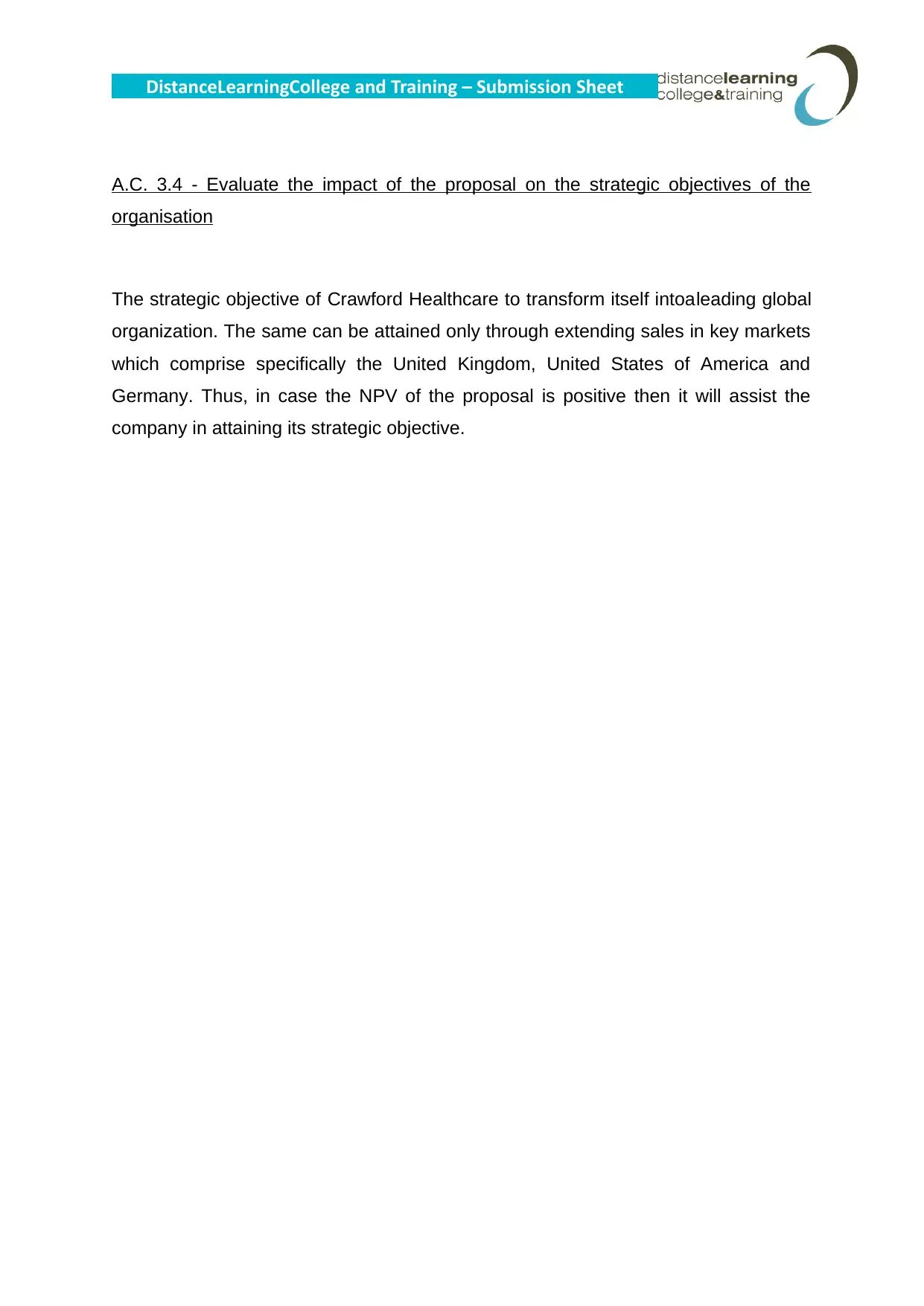
DistanceLearningCollege and Training – Submission Sheet
A.C. 3.4 - Evaluate the impact of the proposal on the strategic objectives of the
organisation
The strategic objective of Crawford Healthcare to transform itself intoaleading global
organization. The same can be attained only through extending sales in key markets
which comprise specifically the United Kingdom, United States of America and
Germany. Thus, in case the NPV of the proposal is positive then it will assist the
company in attaining its strategic objective.
A.C. 3.4 - Evaluate the impact of the proposal on the strategic objectives of the
organisation
The strategic objective of Crawford Healthcare to transform itself intoaleading global
organization. The same can be attained only through extending sales in key markets
which comprise specifically the United Kingdom, United States of America and
Germany. Thus, in case the NPV of the proposal is positive then it will assist the
company in attaining its strategic objective.
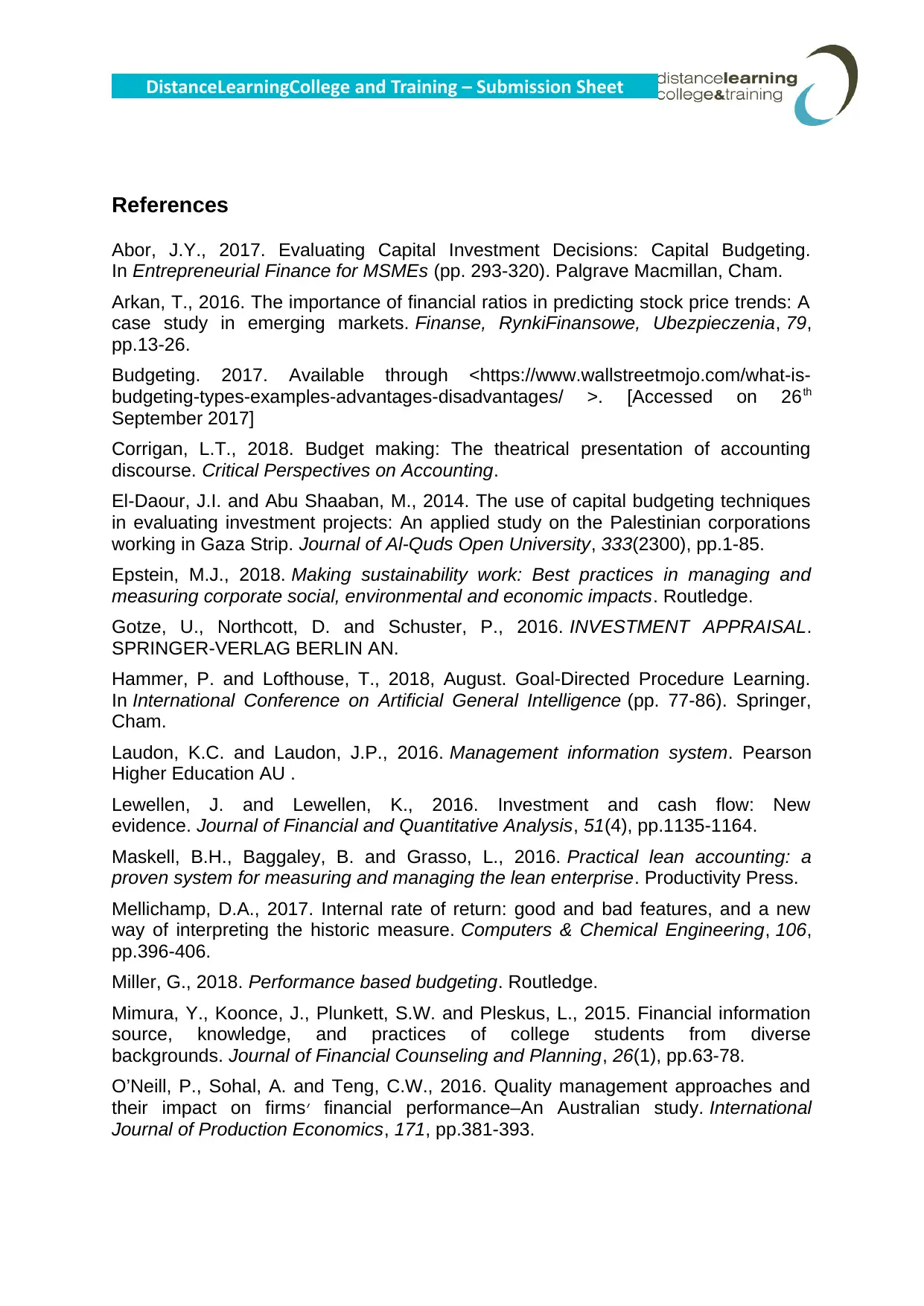
DistanceLearningCollege and Training – Submission Sheet
References
Abor, J.Y., 2017. Evaluating Capital Investment Decisions: Capital Budgeting.
In Entrepreneurial Finance for MSMEs (pp. 293-320). Palgrave Macmillan, Cham.
Arkan, T., 2016. The importance of financial ratios in predicting stock price trends: A
case study in emerging markets. Finanse, RynkiFinansowe, Ubezpieczenia, 79,
pp.13-26.
Budgeting. 2017. Available through <https://www.wallstreetmojo.com/what-is-
budgeting-types-examples-advantages-disadvantages/ >. [Accessed on 26th
September 2017]
Corrigan, L.T., 2018. Budget making: The theatrical presentation of accounting
discourse. Critical Perspectives on Accounting.
El-Daour, J.I. and Abu Shaaban, M., 2014. The use of capital budgeting techniques
in evaluating investment projects: An applied study on the Palestinian corporations
working in Gaza Strip. Journal of Al-Quds Open University, 333(2300), pp.1-85.
Epstein, M.J., 2018. Making sustainability work: Best practices in managing and
measuring corporate social, environmental and economic impacts. Routledge.
Gotze, U., Northcott, D. and Schuster, P., 2016. INVESTMENT APPRAISAL.
SPRINGER-VERLAG BERLIN AN.
Hammer, P. and Lofthouse, T., 2018, August. Goal-Directed Procedure Learning.
In International Conference on Artificial General Intelligence (pp. 77-86). Springer,
Cham.
Laudon, K.C. and Laudon, J.P., 2016. Management information system. Pearson
Higher Education AU .
Lewellen, J. and Lewellen, K., 2016. Investment and cash flow: New
evidence. Journal of Financial and Quantitative Analysis, 51(4), pp.1135-1164.
Maskell, B.H., Baggaley, B. and Grasso, L., 2016. Practical lean accounting: a
proven system for measuring and managing the lean enterprise. Productivity Press.
Mellichamp, D.A., 2017. Internal rate of return: good and bad features, and a new
way of interpreting the historic measure. Computers & Chemical Engineering, 106,
pp.396-406.
Miller, G., 2018. Performance based budgeting. Routledge.
Mimura, Y., Koonce, J., Plunkett, S.W. and Pleskus, L., 2015. Financial information
source, knowledge, and practices of college students from diverse
backgrounds. Journal of Financial Counseling and Planning, 26(1), pp.63-78.
O’Neill, P., Sohal, A. and Teng, C.W., 2016. Quality management approaches and
their impact on firms׳ financial performance–An Australian study. International
Journal of Production Economics, 171, pp.381-393.
References
Abor, J.Y., 2017. Evaluating Capital Investment Decisions: Capital Budgeting.
In Entrepreneurial Finance for MSMEs (pp. 293-320). Palgrave Macmillan, Cham.
Arkan, T., 2016. The importance of financial ratios in predicting stock price trends: A
case study in emerging markets. Finanse, RynkiFinansowe, Ubezpieczenia, 79,
pp.13-26.
Budgeting. 2017. Available through <https://www.wallstreetmojo.com/what-is-
budgeting-types-examples-advantages-disadvantages/ >. [Accessed on 26th
September 2017]
Corrigan, L.T., 2018. Budget making: The theatrical presentation of accounting
discourse. Critical Perspectives on Accounting.
El-Daour, J.I. and Abu Shaaban, M., 2014. The use of capital budgeting techniques
in evaluating investment projects: An applied study on the Palestinian corporations
working in Gaza Strip. Journal of Al-Quds Open University, 333(2300), pp.1-85.
Epstein, M.J., 2018. Making sustainability work: Best practices in managing and
measuring corporate social, environmental and economic impacts. Routledge.
Gotze, U., Northcott, D. and Schuster, P., 2016. INVESTMENT APPRAISAL.
SPRINGER-VERLAG BERLIN AN.
Hammer, P. and Lofthouse, T., 2018, August. Goal-Directed Procedure Learning.
In International Conference on Artificial General Intelligence (pp. 77-86). Springer,
Cham.
Laudon, K.C. and Laudon, J.P., 2016. Management information system. Pearson
Higher Education AU .
Lewellen, J. and Lewellen, K., 2016. Investment and cash flow: New
evidence. Journal of Financial and Quantitative Analysis, 51(4), pp.1135-1164.
Maskell, B.H., Baggaley, B. and Grasso, L., 2016. Practical lean accounting: a
proven system for measuring and managing the lean enterprise. Productivity Press.
Mellichamp, D.A., 2017. Internal rate of return: good and bad features, and a new
way of interpreting the historic measure. Computers & Chemical Engineering, 106,
pp.396-406.
Miller, G., 2018. Performance based budgeting. Routledge.
Mimura, Y., Koonce, J., Plunkett, S.W. and Pleskus, L., 2015. Financial information
source, knowledge, and practices of college students from diverse
backgrounds. Journal of Financial Counseling and Planning, 26(1), pp.63-78.
O’Neill, P., Sohal, A. and Teng, C.W., 2016. Quality management approaches and
their impact on firms׳ financial performance–An Australian study. International
Journal of Production Economics, 171, pp.381-393.
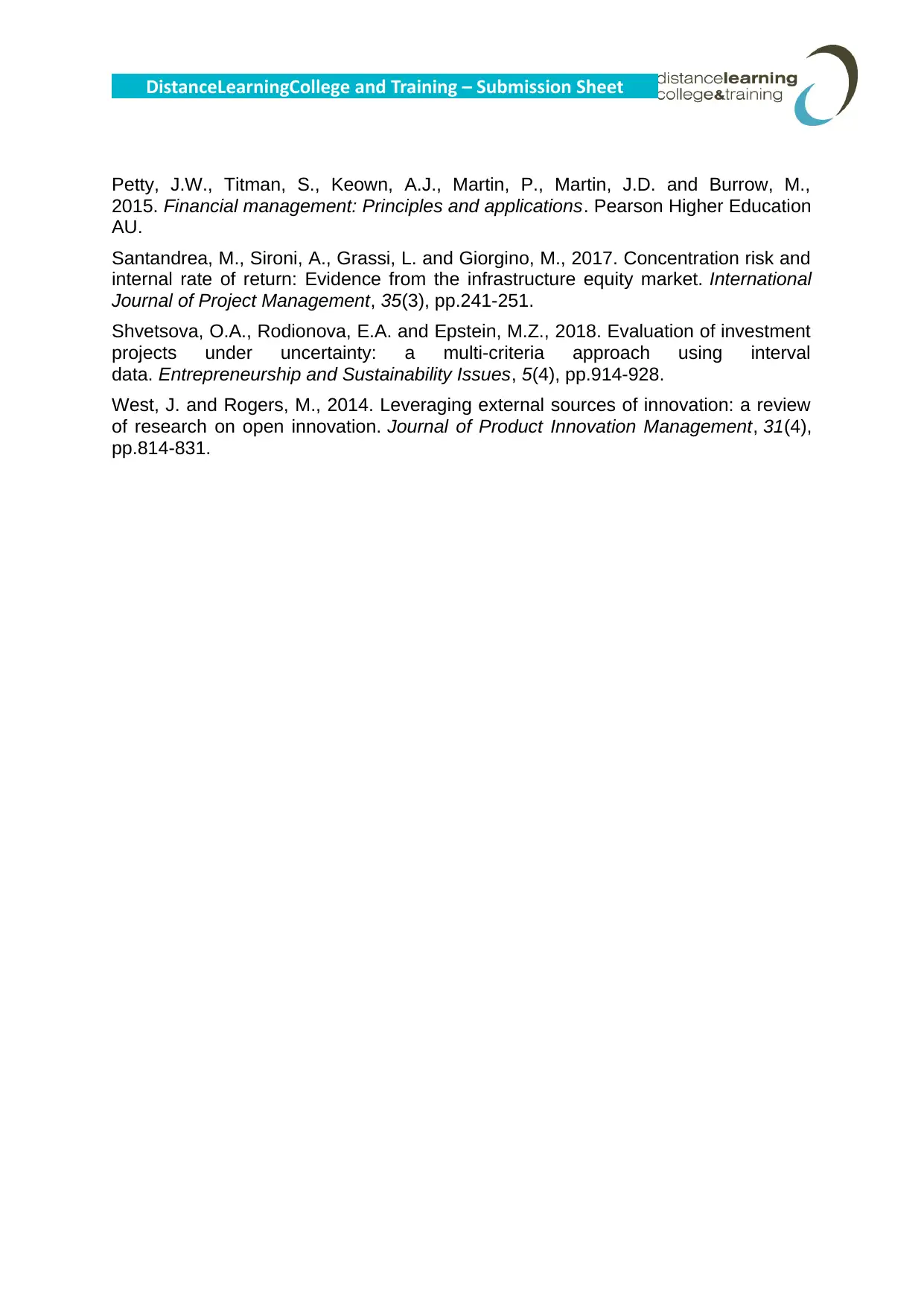
DistanceLearningCollege and Training – Submission Sheet
Petty, J.W., Titman, S., Keown, A.J., Martin, P., Martin, J.D. and Burrow, M.,
2015. Financial management: Principles and applications. Pearson Higher Education
AU.
Santandrea, M., Sironi, A., Grassi, L. and Giorgino, M., 2017. Concentration risk and
internal rate of return: Evidence from the infrastructure equity market. International
Journal of Project Management, 35(3), pp.241-251.
Shvetsova, O.A., Rodionova, E.A. and Epstein, M.Z., 2018. Evaluation of investment
projects under uncertainty: a multi-criteria approach using interval
data. Entrepreneurship and Sustainability Issues, 5(4), pp.914-928.
West, J. and Rogers, M., 2014. Leveraging external sources of innovation: a review
of research on open innovation. Journal of Product Innovation Management, 31(4),
pp.814-831.
Petty, J.W., Titman, S., Keown, A.J., Martin, P., Martin, J.D. and Burrow, M.,
2015. Financial management: Principles and applications. Pearson Higher Education
AU.
Santandrea, M., Sironi, A., Grassi, L. and Giorgino, M., 2017. Concentration risk and
internal rate of return: Evidence from the infrastructure equity market. International
Journal of Project Management, 35(3), pp.241-251.
Shvetsova, O.A., Rodionova, E.A. and Epstein, M.Z., 2018. Evaluation of investment
projects under uncertainty: a multi-criteria approach using interval
data. Entrepreneurship and Sustainability Issues, 5(4), pp.914-928.
West, J. and Rogers, M., 2014. Leveraging external sources of innovation: a review
of research on open innovation. Journal of Product Innovation Management, 31(4),
pp.814-831.
Secure Best Marks with AI Grader
Need help grading? Try our AI Grader for instant feedback on your assignments.
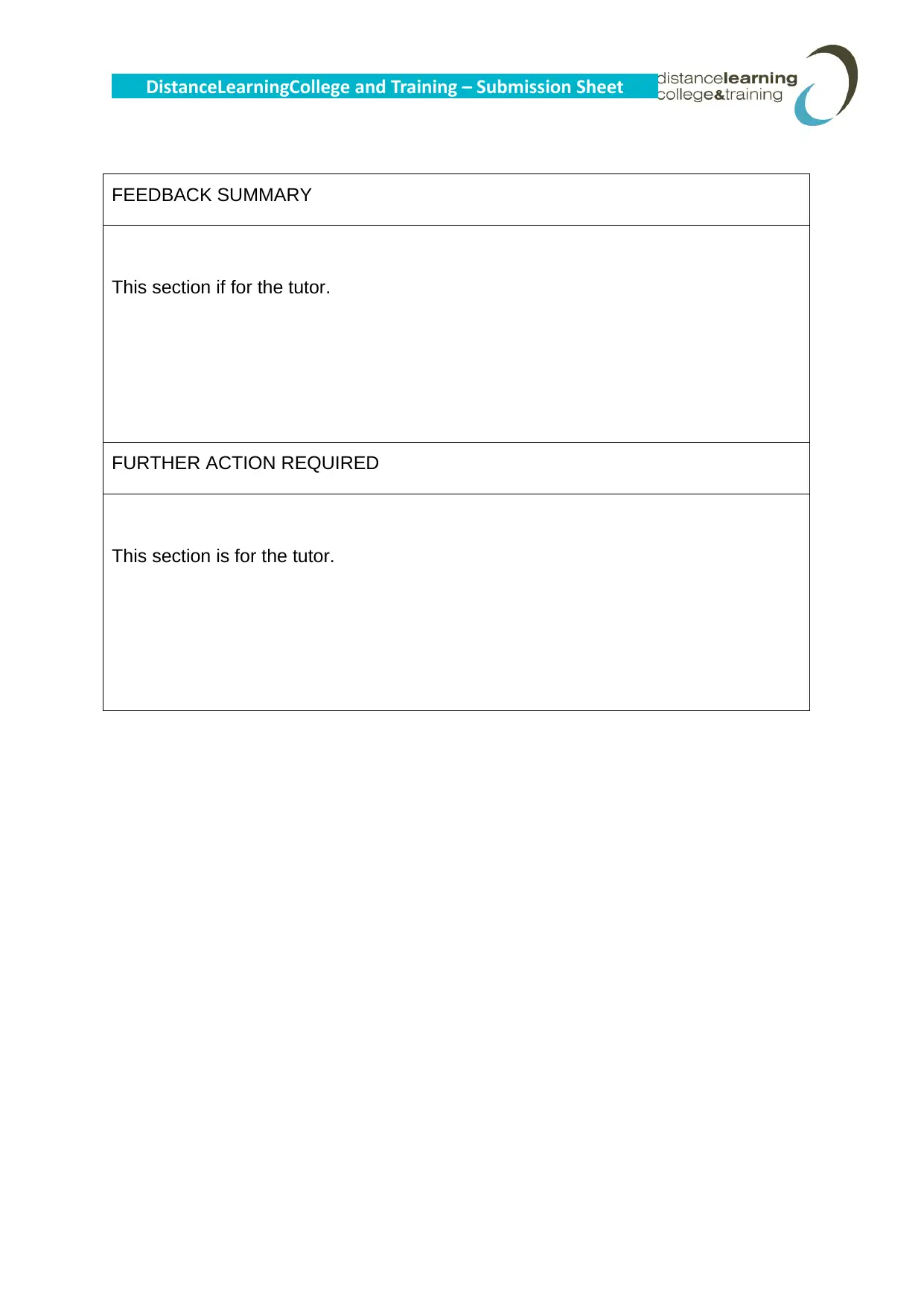
DistanceLearningCollege and Training – Submission Sheet
FEEDBACK SUMMARY
This section if for the tutor.
FURTHER ACTION REQUIRED
This section is for the tutor.
FEEDBACK SUMMARY
This section if for the tutor.
FURTHER ACTION REQUIRED
This section is for the tutor.
1 out of 23
Related Documents
Your All-in-One AI-Powered Toolkit for Academic Success.
+13062052269
info@desklib.com
Available 24*7 on WhatsApp / Email
![[object Object]](/_next/static/media/star-bottom.7253800d.svg)
Unlock your academic potential
© 2024 | Zucol Services PVT LTD | All rights reserved.





